- June 1st: June is Ohio Wine Month! Here is a list of Ohio wines to explore!
- June 2nd: Witness the Greatest Story Ever Told at Living Word Outdoor Drama
- June 3rd: Visit Ohio Village for a summer event
- June 4th: Have fun at a local festival!
- June 5th: Stop by Hafle Winery, one of Ohio’s original wineries
- June 6th: Drop in on Powell Winery for Excellent Food and Wine
- June 7th: Purchase Produce at Your Local Farmer’s Market
- June 8th: Plan a vacation or long weekend at Geneva on the Lake
- June 9th: Walk Across Cincinnati’s Purple People Bridge
- June 10th: Sample Wines at Kinkead Ridge
- June 11th: Stay at Buccia Vineyard Winery Bed and Breakfast in Conneaut
- June 12th: Bring Your Chairs for a Picnic on the Lawn at the Winery at Wolf Creek
- June 13th: Stop by at Happy Hour for Wine at Kennedy Vineyard
- June 14th: Sample Some Fantastic Sweet Wines at Brandeberry Winery
- June 15th: Indulge in Some Much Needed Wine Therapy at Myrrdin Winery
- June 16th: Explore the Shawshank Trail in Mansfield
- June 17th: Mon Ami is now Gideon Owen Wine Company
- June 18th: Understand How the Treaty of Green Ville changed US History at The Garst Museum
- June 19th: Order Award Winning Wines at Raven’s Glenn Winery in Coshocton
- June 20th: Eat and Drink Your Way Through Mansfield at The Vault Winery
- June 21st: Pull up to the Dock at Buckeye Lake Winery
- June 22nd: Explore Ohio History at Sauder Village, Part 1*
- June 23rd: Learn about Ohio History at Sauder Village, Part 2*
- June 24th: Immerse Yourself in Ohio History at Sauder Village, Part 3*
- June 25th: Cincinnati’s Sawyer Point and Yeatman’s Cove
- June 26th: Pack a Picnic and Enjoy the Ohio Skyline from Devou Park
- June 27th: Pick up fresh produce at your local Farmer’s Market (Canal Market in Newark)
- June 28th: Take a Roadtrip to Halliday’s Winery
- June 29th: Hike Glacier Ridge Metro Park near Columbus
- June 30th: Ohio Wine Month! Drink Local! Try Henke Winery!
Tag Archives: Sauder Village
Making Friends with the Early Ohio Settlers at Sauder Village, Part 3
What a spectacular morning visiting the historical buildings of Sauder Village. On the Village Green, I explored the 1920’s Grime Homestead, admired the adorable farm animals, rode the free express train and explored the Natives and Newcomers exhibit. The remaining sites to explore are the Pioneer Settlement, the Little Pioneers Homestead, the Historic Community and the places in between.
I hope you have had the opportunity to read Parts 1 and 2 of my Sauder Village blog to put this amazing complex in perspective and to understand Sauder Village’s extraordinary beginnings.
Celebrating forty years as Ohio’s Largest Living History Destination, Sauder Village is an amazing replica of a small town dating back from 1803 to the 1920s. From the Natives and Newcomers Exhibit to the Pioneer Settlement there are close to forty buildings that will transport you to another place and time. I hope you enjoy the second part of my fun adventure at this attraction that ranks high on my list of places to see in Ohio.

When the Lauder family settled in northwestern Ohio, the area was considered a Black Swamp. Due to the conditions of the land, logs were laid side by side to accommodate carts and wagons, despite the bumpy ride.
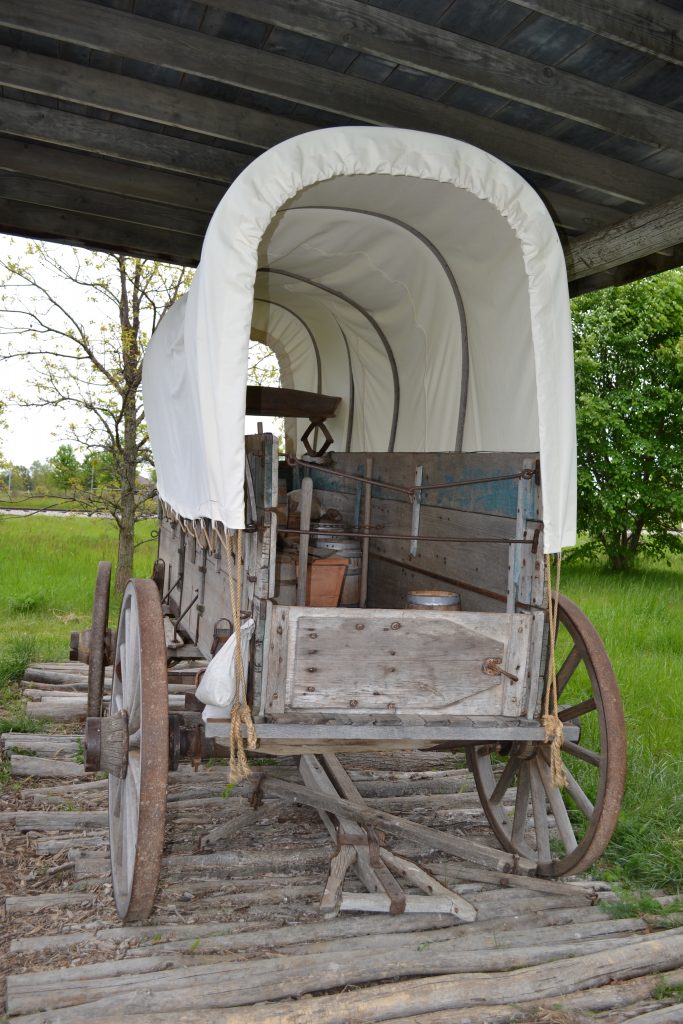
It was also dangerous for the horses as their legs could be trapped between the logs. Regardless of the difficulties in crossing through the swamp, it seemed to have made transportation a little easier.

Inside of the early settlement of the Lauber family, they lived in temporary lean to structures until their homes are completed.
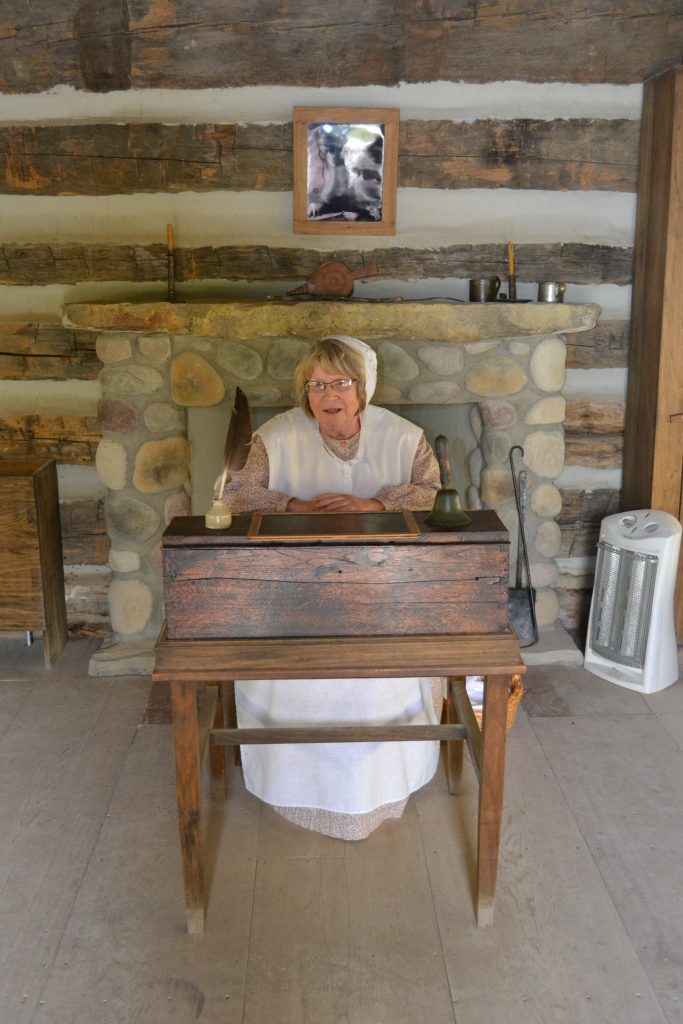
The log school is a recreation of a one-room schoolhouse that would have existed in the 1840s. Because the lighting inside was limited, the desks would face the walls where greased paper took the place of windows. The fireplace would keep the teacher and children warm, but overall, the schoolhouse was quite primitive.

During my visit to the Witmer-Roth home, it was already closed for the day. When open, there is a costumed guide that prepares a meal on either the stone hearth indoors or the outdoor bake oven. This is the original home of Anna Sauder Witmer-Roth, where she gave birth to ten of her 15 children. It is here where visitors can learn more about the woman’s role during the days of the early settlers.
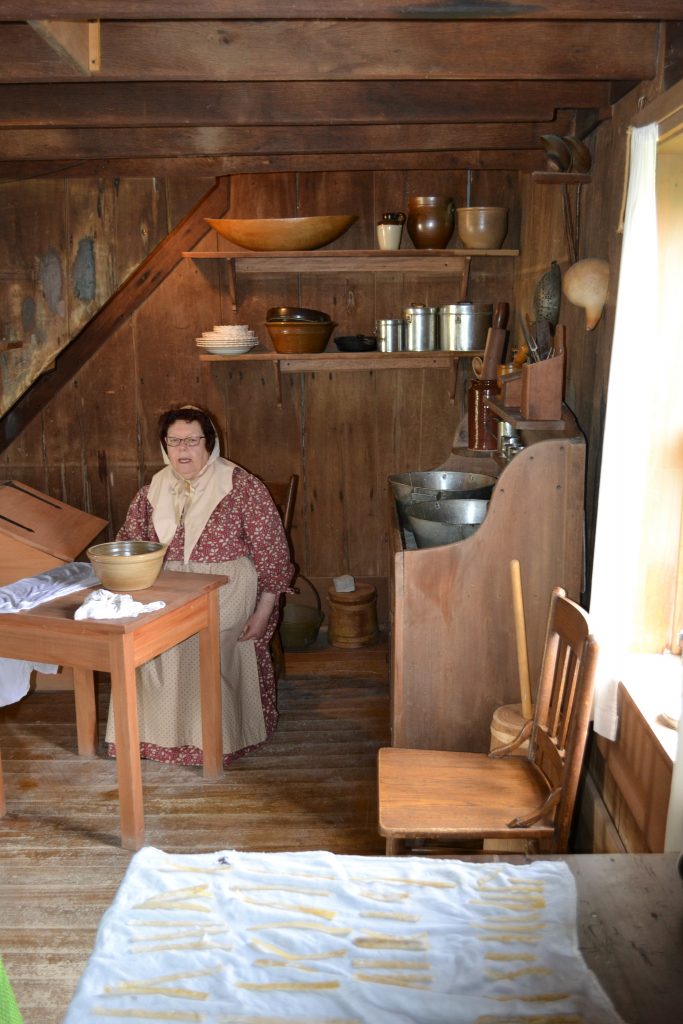
Inside of the Etcher Cabin, a guide is making homemade noodles. She explains to me that this home was once owned by Jacob and Barbara Etcher who arrived in this area sometime in the 1850s.
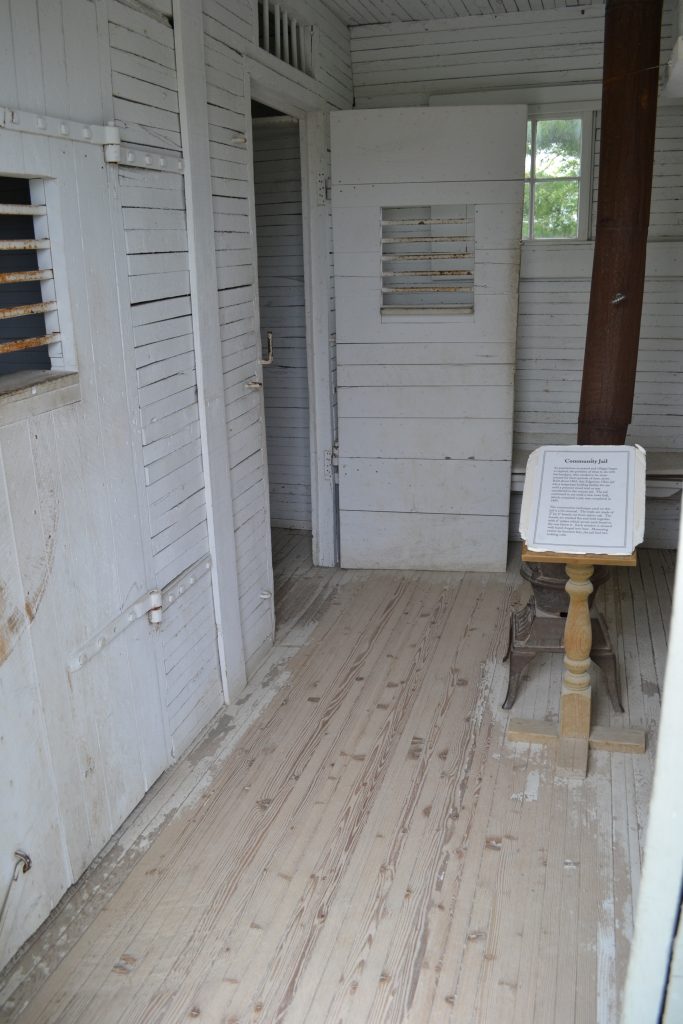
The community jail on the premises was built in the late 1860s to house criminals in Edgerton, Ohio. Interestingly, there are only two cells as this was a temporary facility until the criminal stood trial.

The Peter Stuckey Farm includes the home, garden, summer kitchen, barn and wagon shop. Built in the 1870s, it was home to both him and his wife Catherine (Yoder). As a result of the drainage of the swamp, their farm became prosperous. Peter was also a successful wagon maker as well.
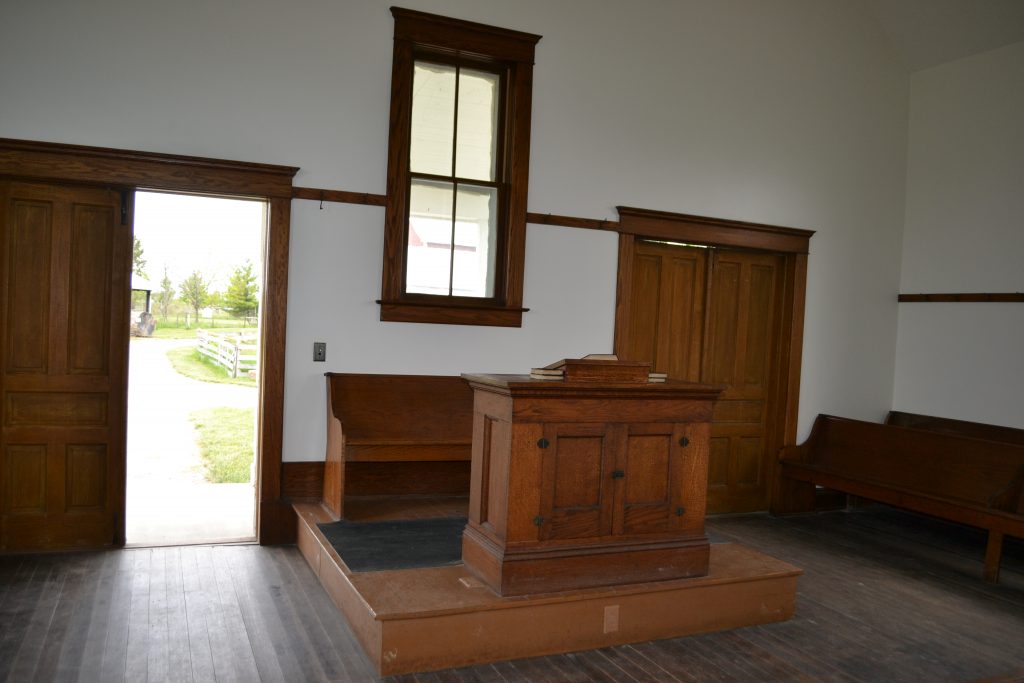
Building number 34 is the depot where the train stops to pick up passengers and drop them off to explore the Pioneer Settlement.
The next building is the Holdeman Church which was originally a Menonite Church from the local town of Pettisville and was once known as the Church of God in Christ Mennonite. It is here where the horse and buggy ride originates and requires a small additional fee.
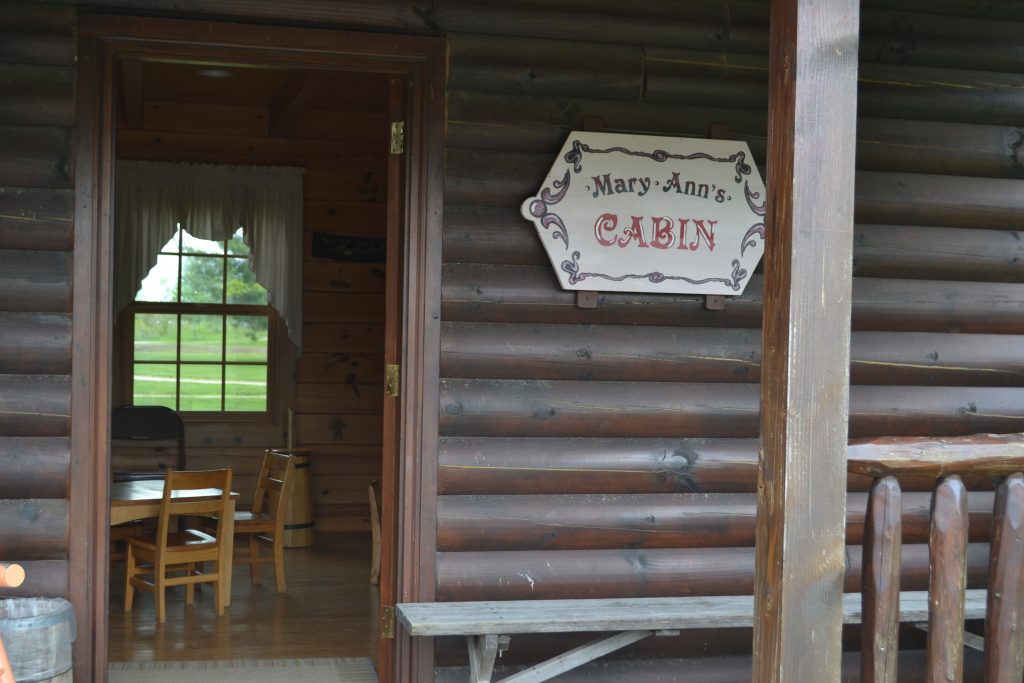
The Little Pioneers Homestead is specifically geared towards young children and their families. There is a small cabin, Mary-Anne’s cabin and Miller barn where they can milk the cow.
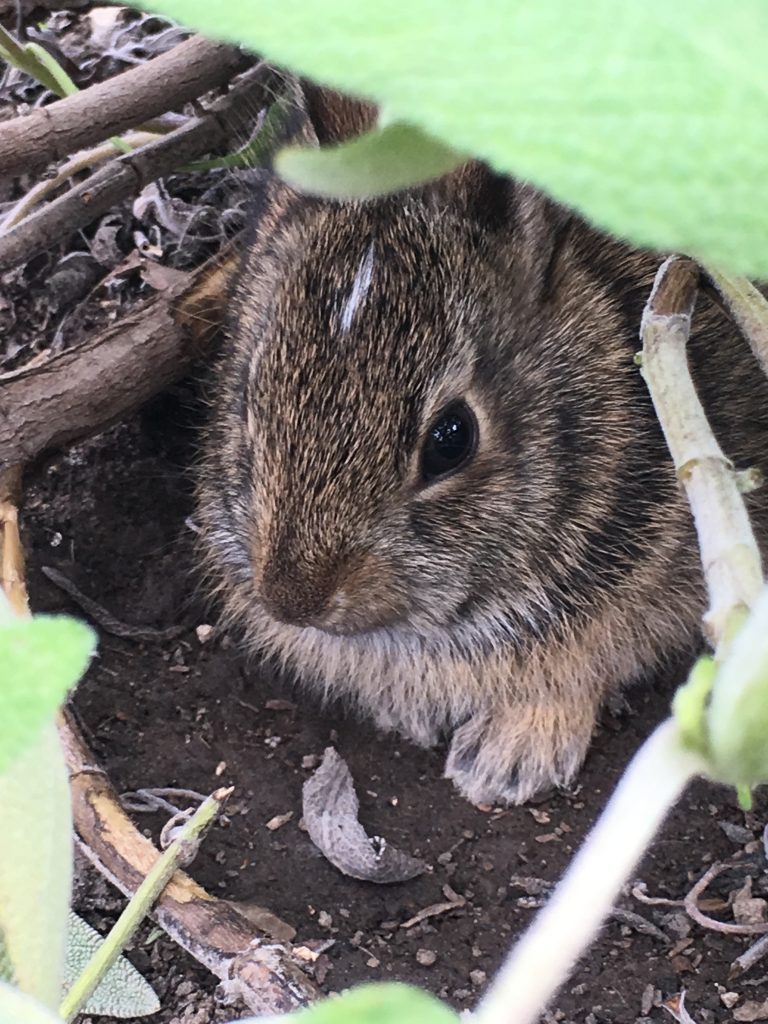
One of my favorite parts of the day was finding a baby bunny in the Discovery Garden!
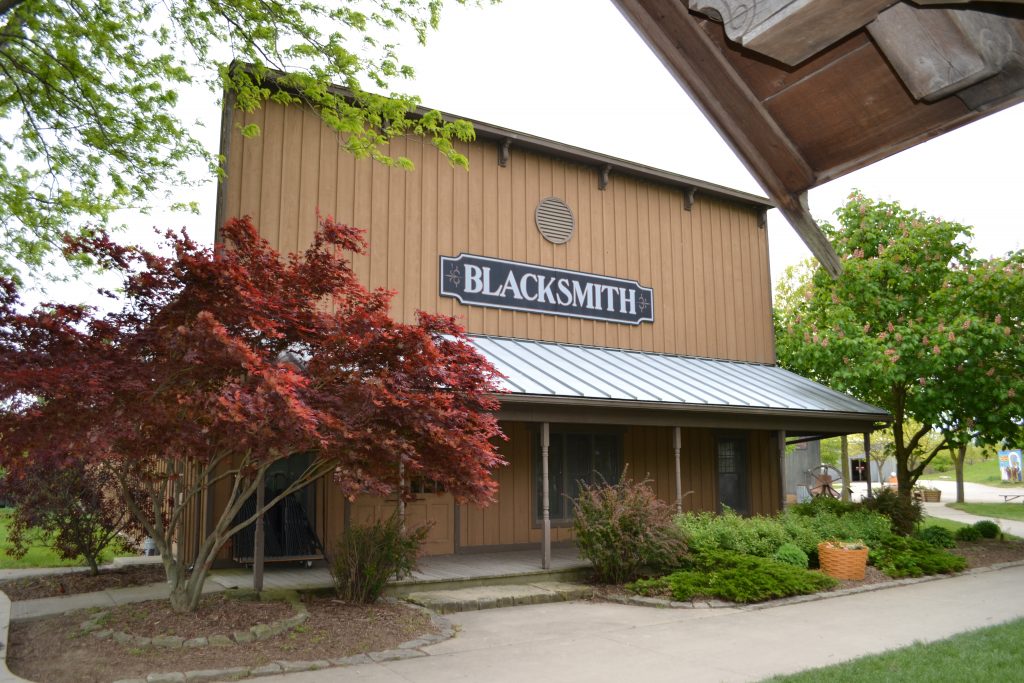
The Blacksmith Shop was temporarily closed.
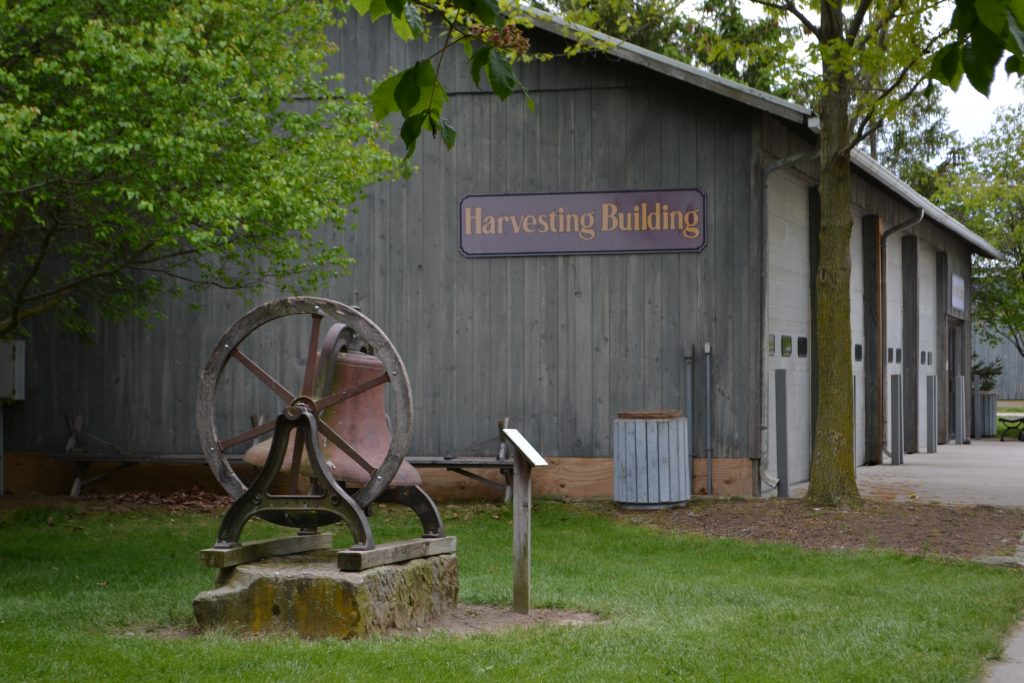
The Harvesting Building is another special event space and location for group lunches and picnic space.
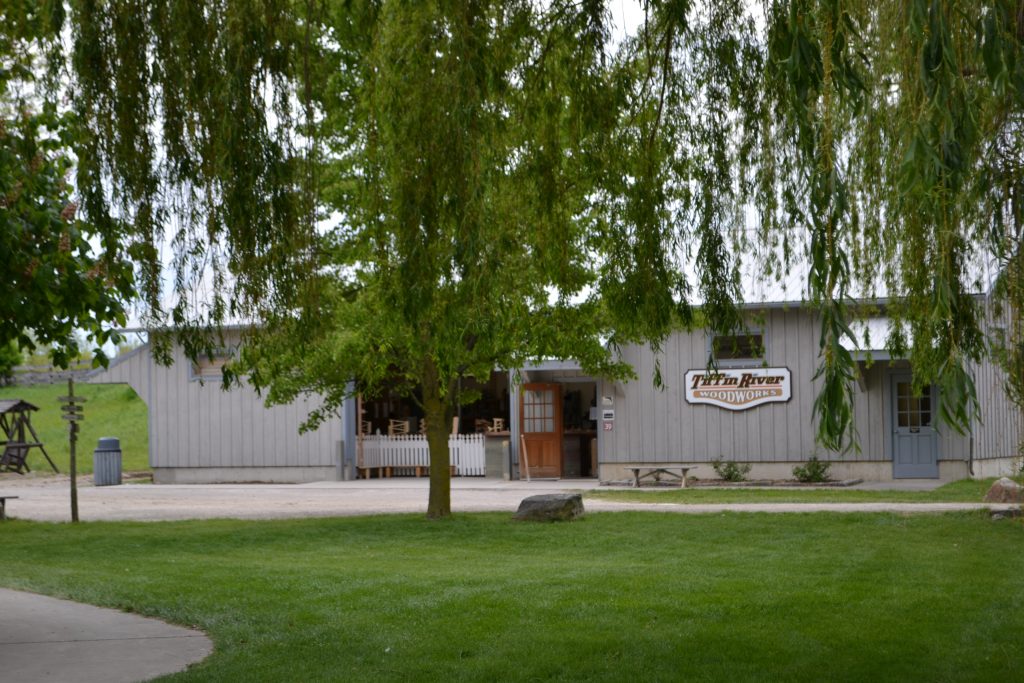
The Tiffin River Woodworks is a workshop where wooden products, including toys, are made and Cider Mill is only used in the month of September during Sauder Village’s Apple Week.
It has taken me the full day to explore Sauder Village and I have had such an awesome day exploring this gem of northwest Ohio!
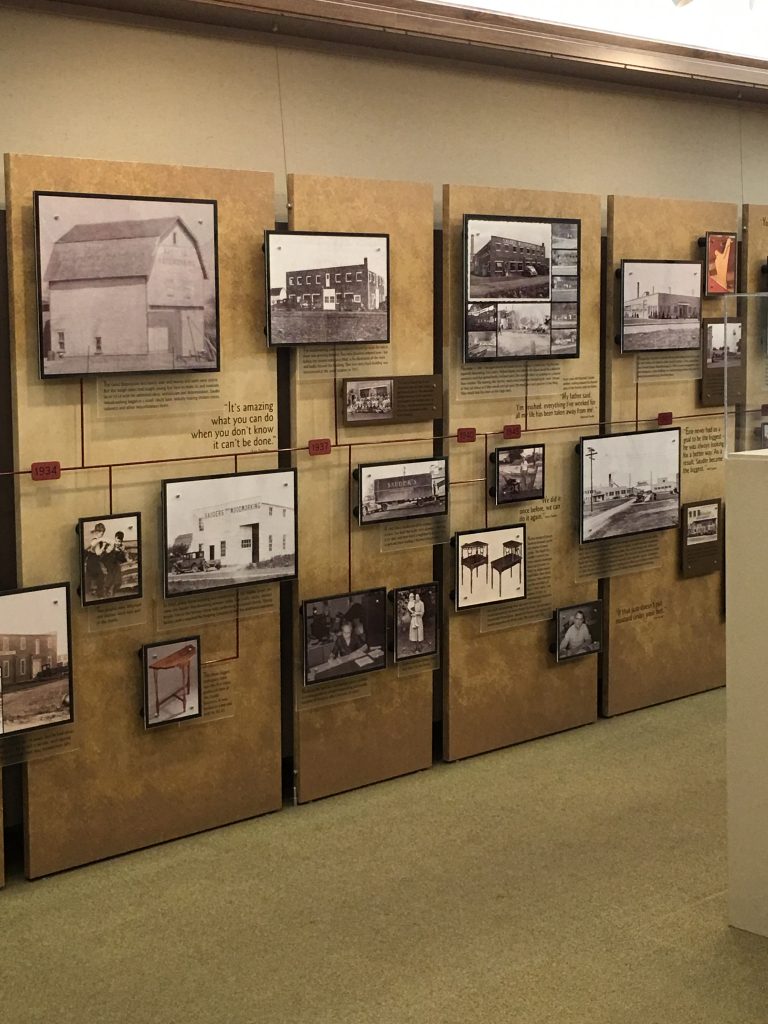
I have reentered the welcome center where I find the Greenburg Gallery exhibit that provides more detail about Erie Sauder, Sauder Village and the making of this spectacular attraction.
In addition to the village, there is a campground, the Barn Restaurant, Doughbox Bakery and Sauder Store and Outlet within walking distance. With so much to experience, one could really spend a long weekend here.
Have you had the opportunity to visit Sauder Village? What was your favorite sight or activity while you were here? I would love to hear about your experience if you would kindly leave a message in the comments section below! Many Thanks and Happy Travels!
What to See and What to Do:
Sauder Village Living History and Farm
221611 OH-2
Archbold, OH 43502
Telephone: 419 446 2541
- Admission Fee: Adults: $24; Students, Ages 4 – 16: $18; Children, Ages 3 and under: Free; Seniors 60 and over: $22. person is permitted. 2-day Admission: Adults, $38; Students, Ages 4 – 16: $26; Valid for 2 consecutive days, non-transferable. AAA Discount: $2
- Hours: Spring (May 3 – 27): Open Wednesday to Saturday from 10AM to 3:30PM; Saturday 10AM to 4PM; Summer (May 31 – September 2): Open Wednesday to Saturday from 10AM to 5PM and Closed Sunday, Monday and Tuesday. Fall Hours (September 6 – October 8); Open Wednesday to Friday from 10AM to 3:30PM and Closed Sunday, Monday and Tuesday.
- Length of the Tour: From 2 hours to 2 days.
- Tips for Your Visit: Wear comfortable shoes as you walk through time visiting historical buildings. Download the map ahead of time and plan your day. There are several classes and demonstrations that you won’t want to miss. While there are several small shops to visit, make plans to eat at the Barn Restaurant for down-home cooking.
Where to Stay:
Sauder Heritage Inn
22611 State Route 2
PO Box 235
Archbold, OH 43502
Telephone: 800 590 9755
If you are traveling by RV, make reservations at the Sauder Village Campground.
Where to Eat:
The Barn Restaurant
22611 State Route 2
PO Box 235
Archbold, OH 43502
Telephone: 800 590 9755
Select the buffet or order from the menu loaded with down-home recipes.
What to Eat:
- Meatloaf with Mashed Potatoes
- Soups and Salads
- Fried Chicken
- Roast Beef Dinners
What to Read:
- Heritage of the Black Swamp, by Cynthia Covert Harger
Photo Guide to Sauder Village
- Visit Sauder Village in the spring for newborn baby animals
Making Friends with the Early Ohio Settlers at Sauder Village, Part 2
I spent the morning visiting the historical buildings located on the Village Green and those in the outer perimeter. The structures built in the early 20th century include the 1920’s Grime Homestead, Building 19 on the Complex Map. This has been such a fabulous, educational experience learning about the history of each of the buildings as well as exploring the items that are inside relating to the type of building, shop or museum. I hope you have had the opportunity to read Part 1 of my Sauder Village blog to put this amazing complex in perspective and to understand Sauder Village’s beginnings.
Celebrating forty years as Ohio’s Largest Living History Destination, the Village is an amazing replica of a small town dating between the years 1803 to the 1920s. From the Natives and Newcomers Exhibit to the Pioneer Settlement there are close to forty buildings that will give you a glimpse of a time in US history with abundant growth and change.

The 1920s Grime Homestead looks practically like any other farm house that one would see in Ohio. A beautiful representation of our country’s “Modern Era”, this home is very similar to those we would see today without many of the technological advancements.

Friendly costumed guides are staged throughout the structures, replicating the activities of daily life at this time. Inventions, such as the gas range reduced the amount of time to prepare family meals. Our guide explained the process of gathering the ingredients of the meal using items the farm such as flour and eggs. Using the appliances and kitchen gadgets from that era, she explained the steps to ready her meal and offered samples of the pie she had prepared in advance.

The dining room, located off of the kitchen also served as a casual family room. Furniture included a table and chairs, a couch, phonograph and radio as well as wall decorations. Unlike the prevous rooms, this floor was carpeted. I learned that carpeting symbolized the wealth of a family, able to afford some of the nicer things in life and were considered well-off financially.

Entering the parlor, I was immediately drawn to the upright player piano reminiscent of the one I had as a child. This space in the house was set aside for entertaining guests and housed the more delicate possessions of the family, such as expensive furniture and family heirlooms.

The master bedroom, typical of one that you would find in the 1920s, was simple yet functional. The women loved vanities and dressing tables with benches. During this era, it was not uncommon to find furniture made out of veneer to help reduce the cost.

Downstairs, the large cellar served as a pantry and cooler for storing meat and milk. Because grocery stores were not as readily accessible in the 1920s, the lady of the house would can fruits and vegetables then place them on shelves until she was ready to use them.

The cellar also housed the laundry for cleaning of the clothes, hanging them out to dry and then ironing them on a regular basis.
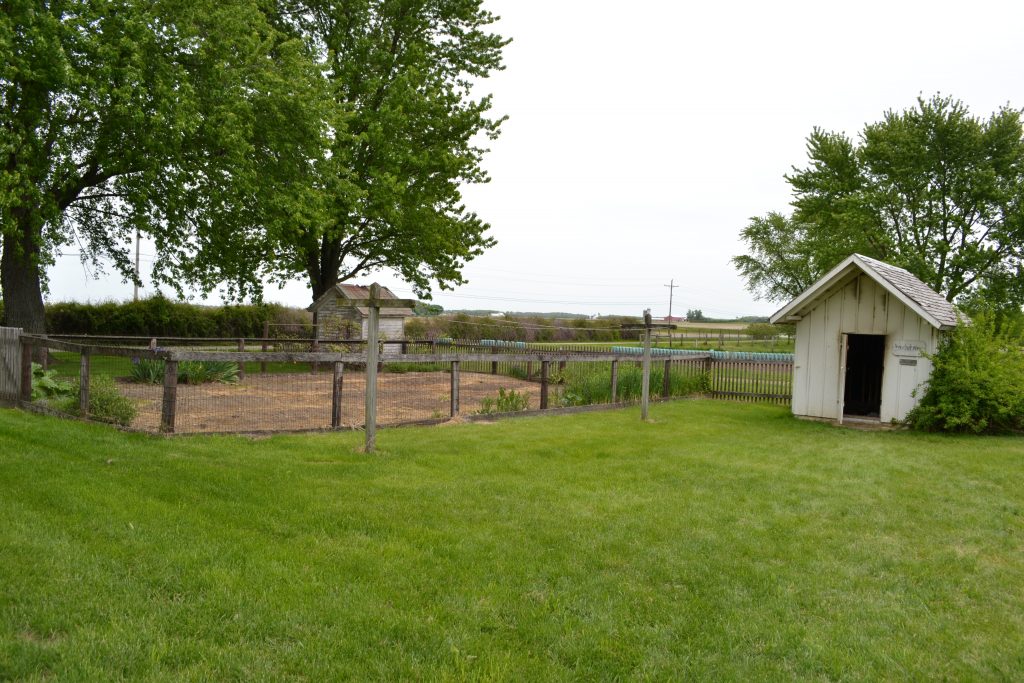
Exiting the cellar into the outdoors was a garden, storage shed and outhouse. A garden’s size was based on the number of family members in the home as the produce was used to feed the family.
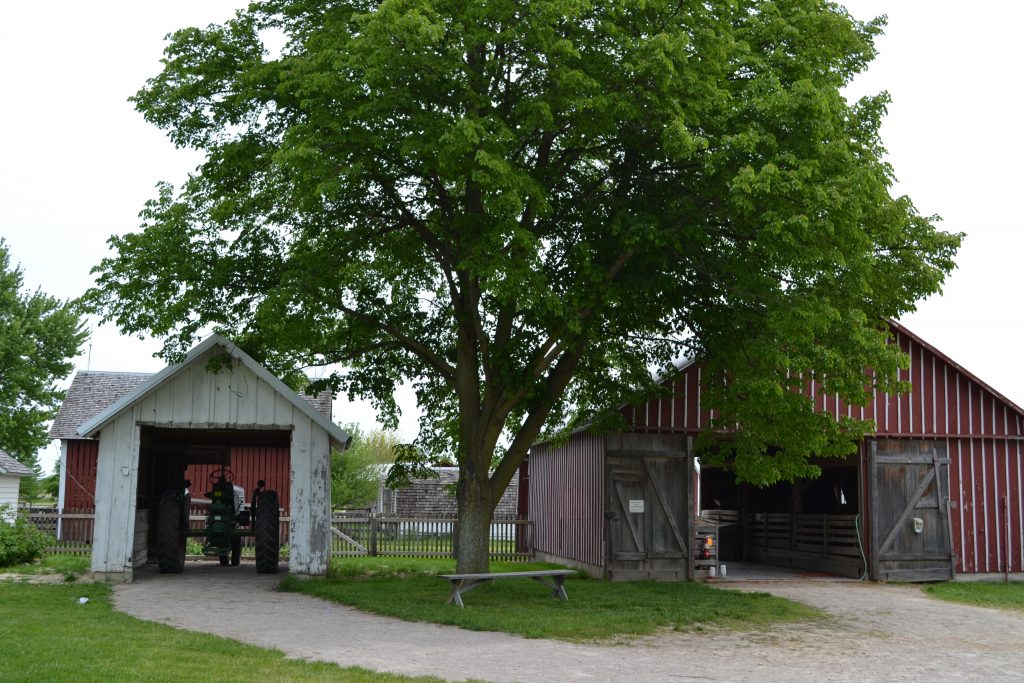
Before reaching the festival barn, I passed the garage that held the tractor. This was the first motorized vehicle on the property. I was so excited to see all of the farm animals and spent most of my time in this part of the village.
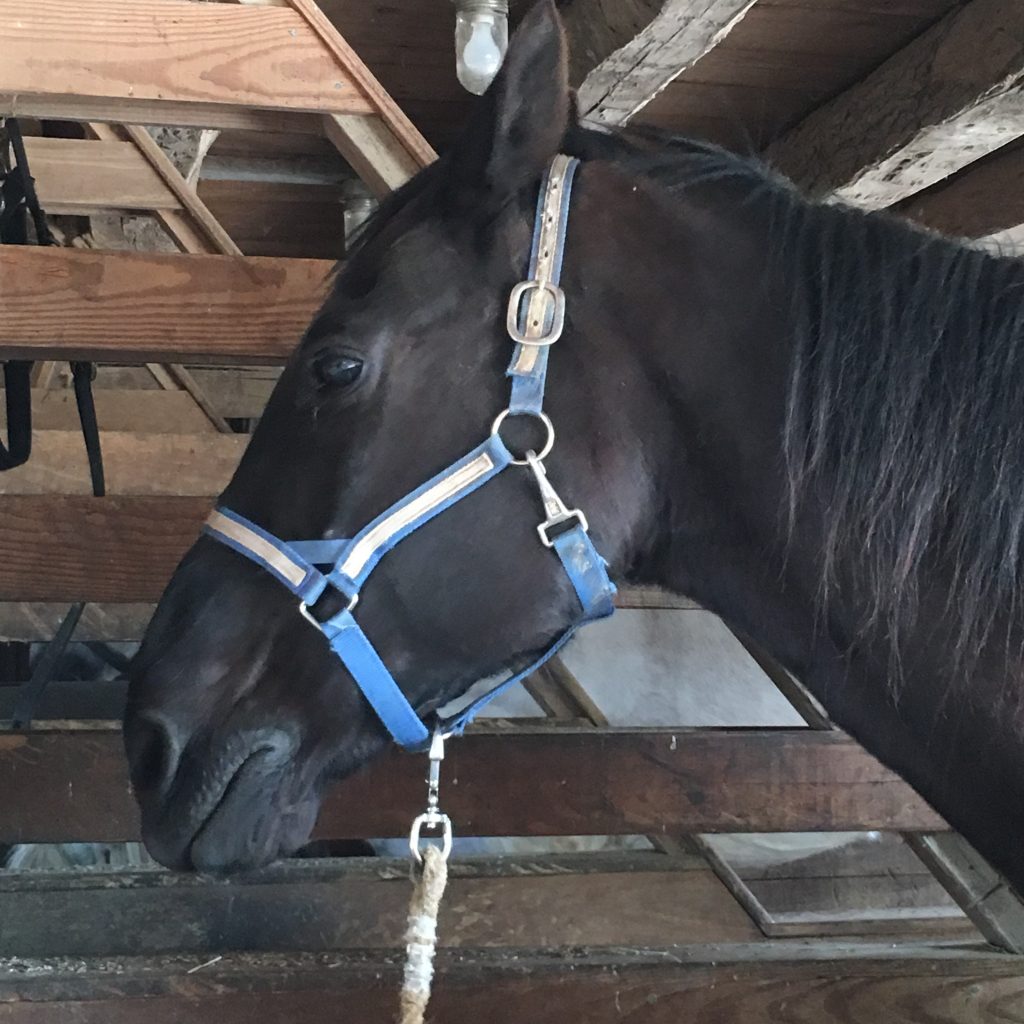
There are horses….
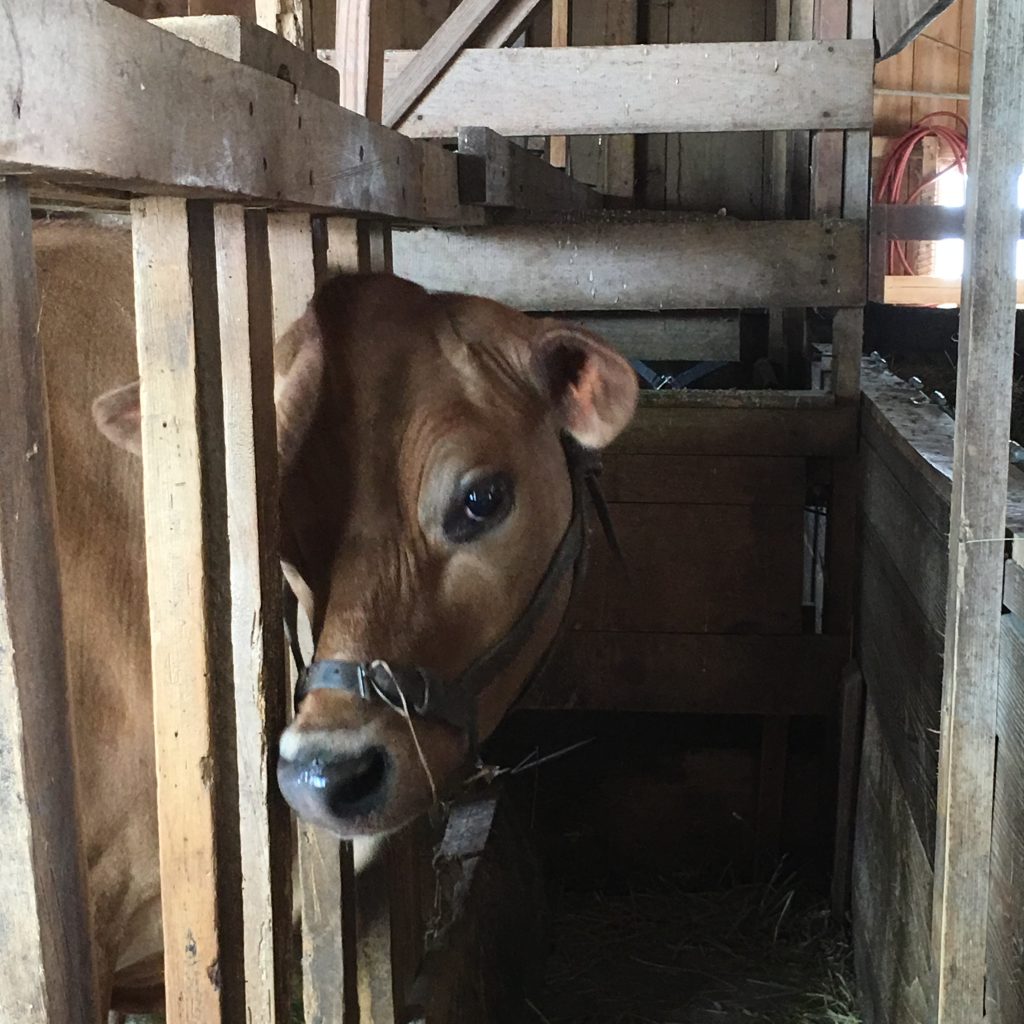
Cows….
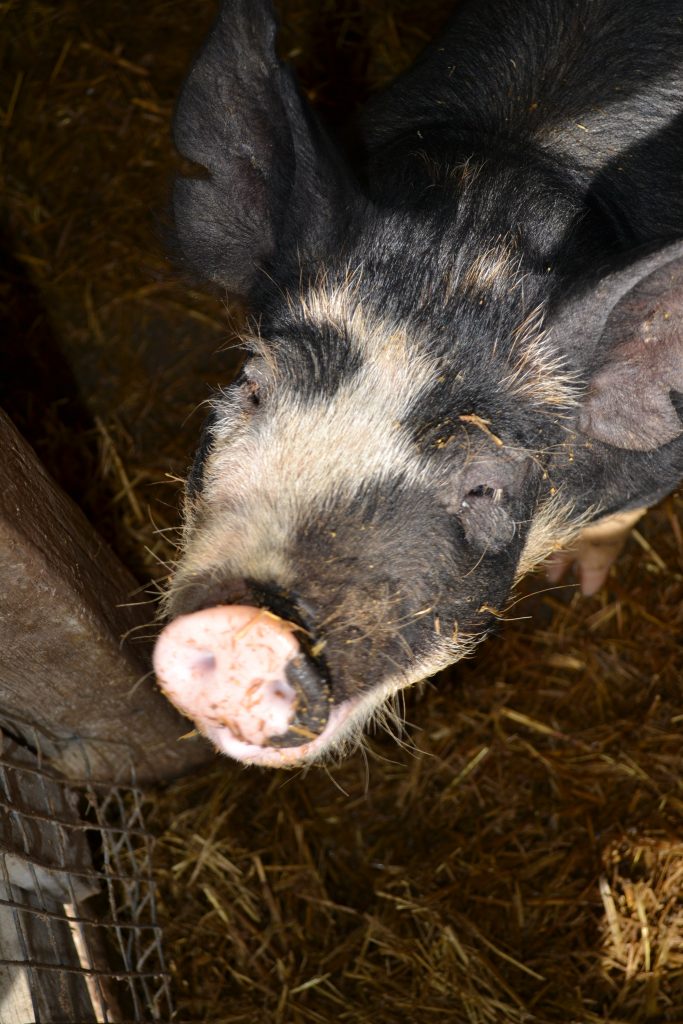
Pigs…
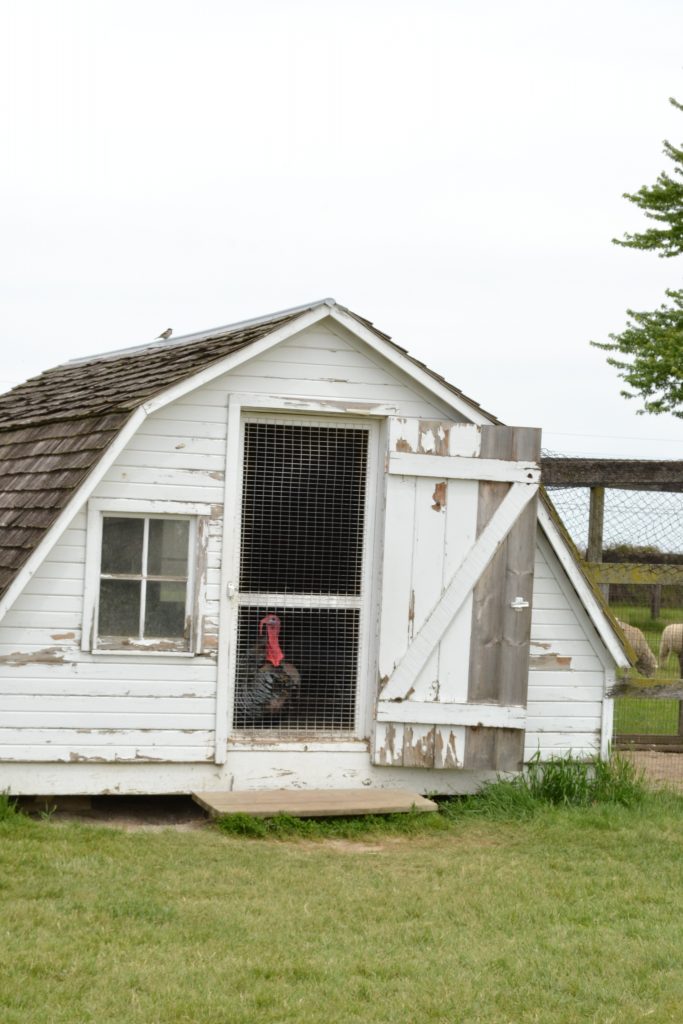
Turkeys…
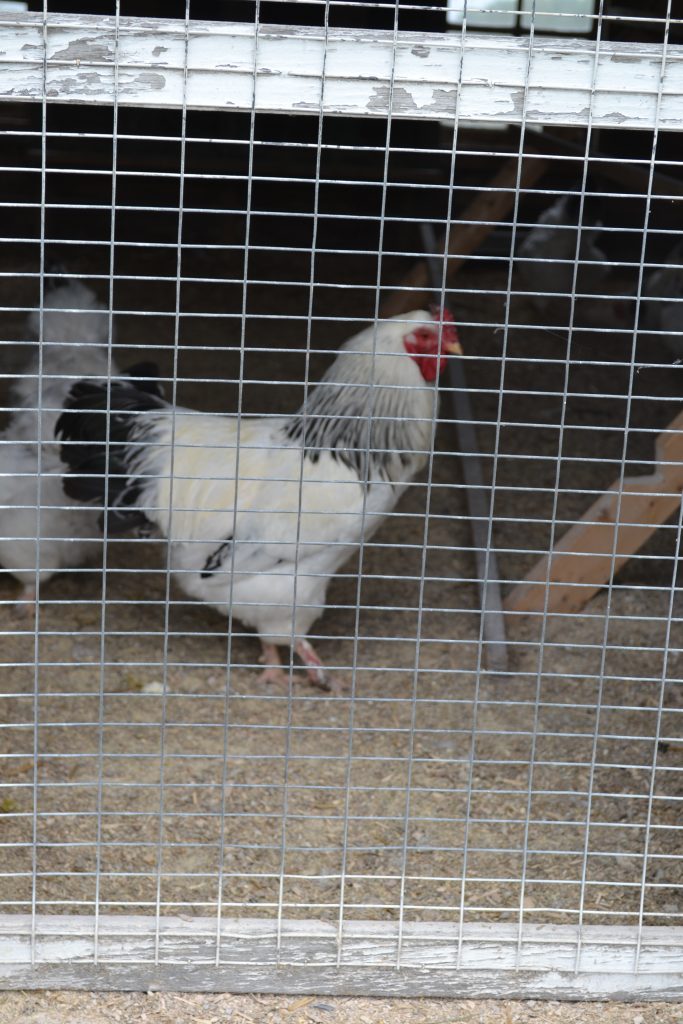
and chickens…but my favorite of all of the animals was…..
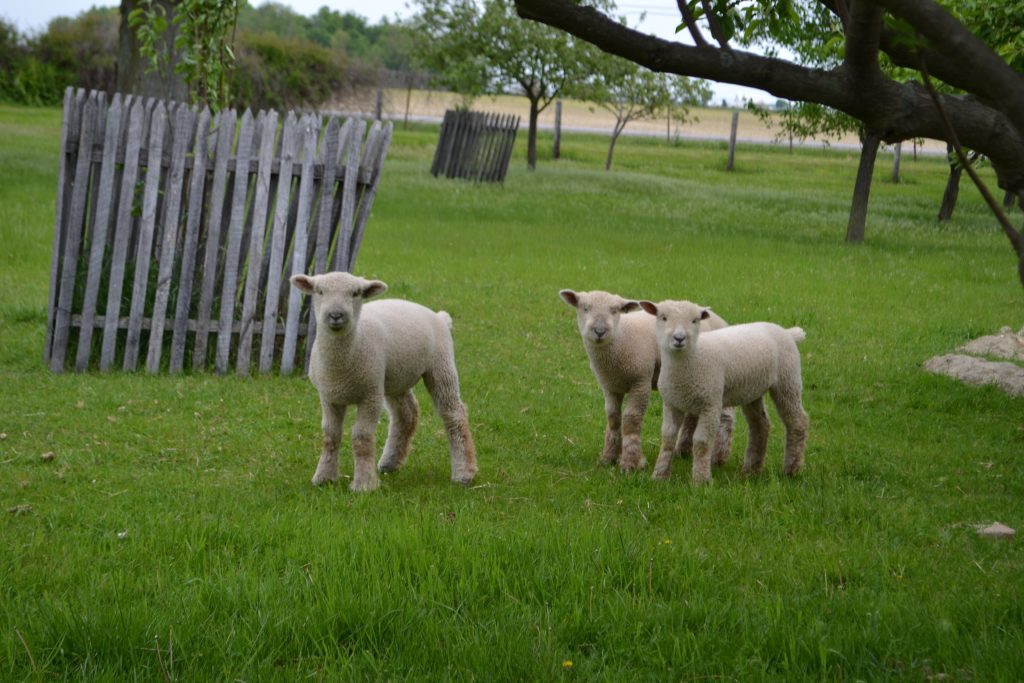
the baby lambs!
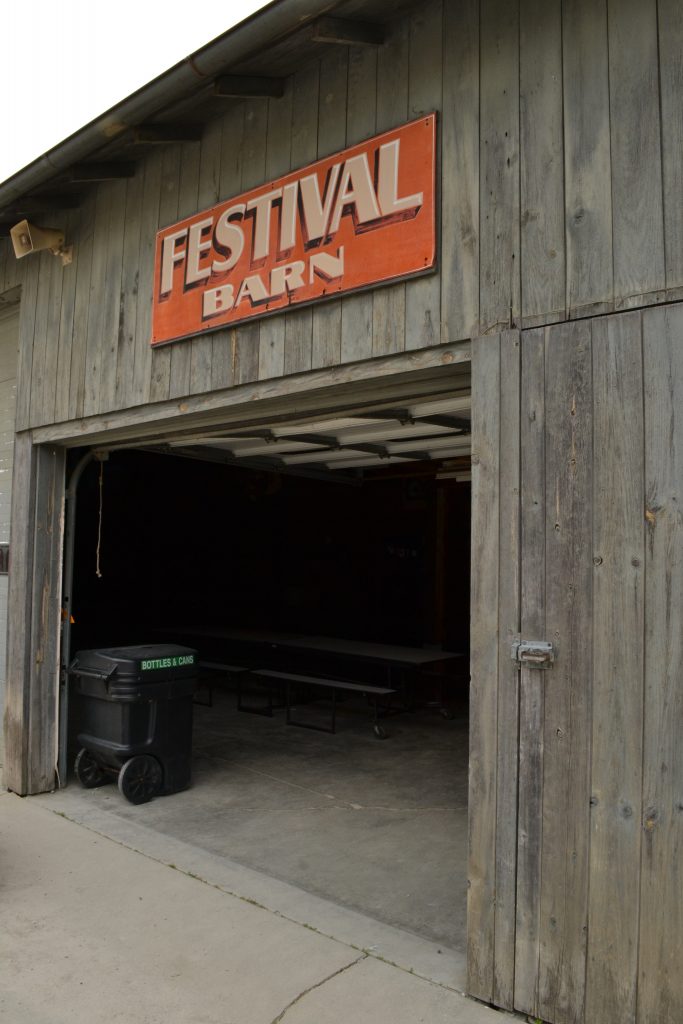
The Festival Barn is used strictly for entertainment purposes only holding special events, picnics and group lunches for visitors.
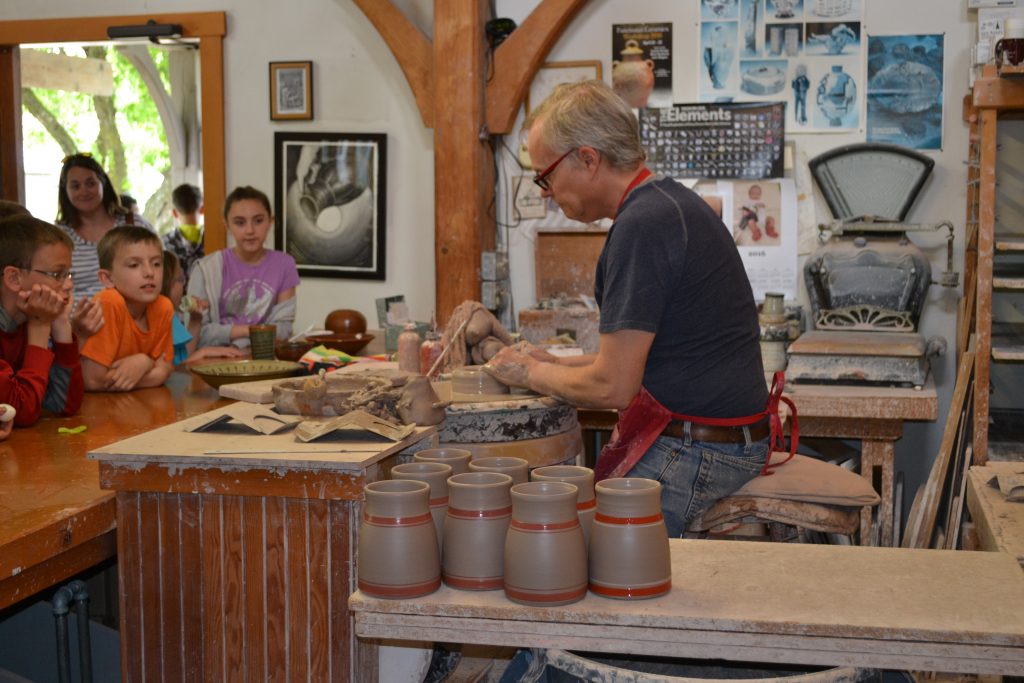
Over the bridge I arrived at Brush Creek Pottery where I found Mark Nafziger, the resident potter creating a bowl. With so many types of pottery on display, I browsed through the flower pots, vases, plates and decorative items exploring all of their designs and shapes.
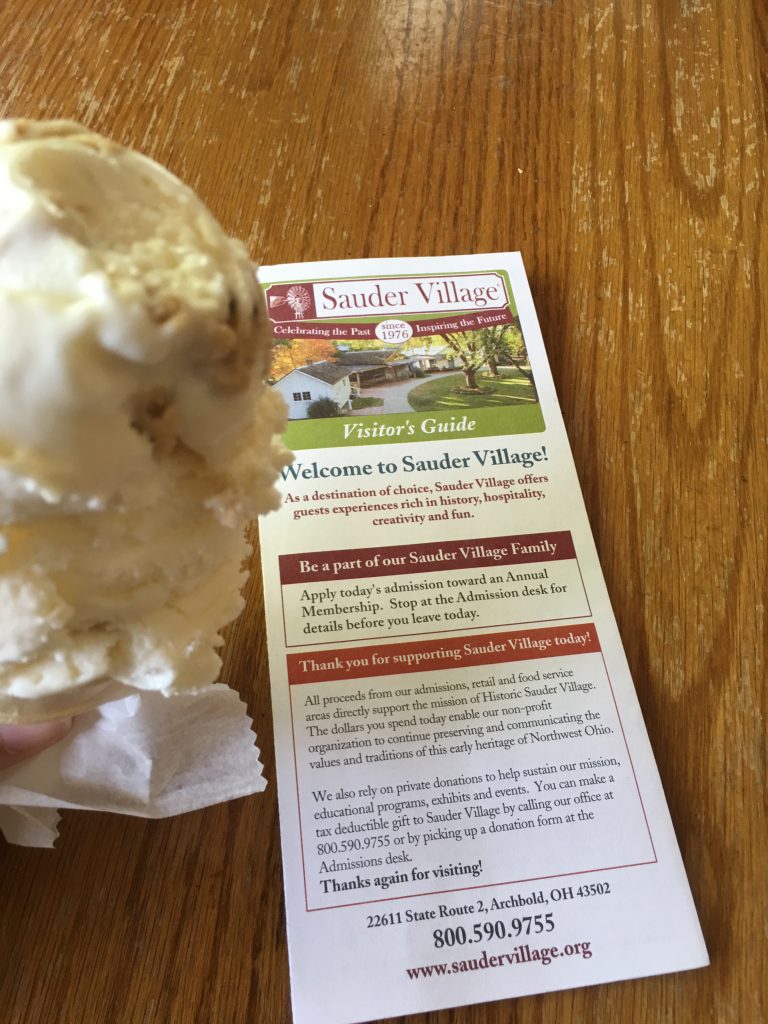
Building 22 is a storage shed for employees only, but I can’t wait to visit the next building…the Ice Cream Parlor. A perfect time for a break, I ordered a single, hand-dipped ice cream in cookie dough on a sugar cone, super creamy and delicious.
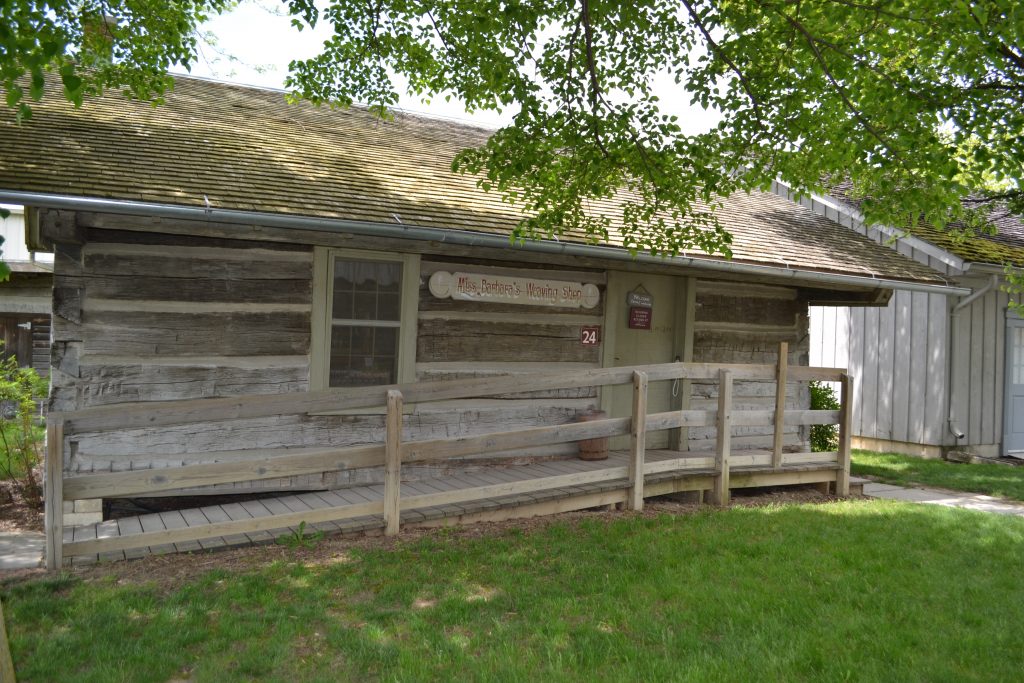
Barbara’s Weaving Shop was closed, but on days that it is open, weavers use the barn’s frame loom to create beautiful items out of both threads and rags.
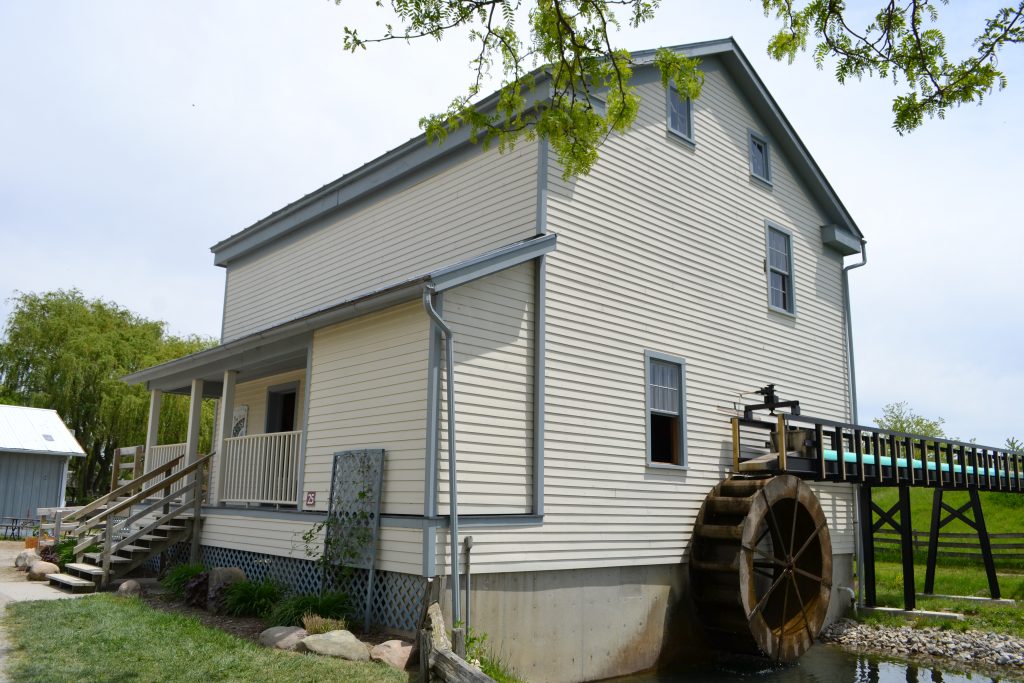
The water-powered grist mill at Sauder Village is one of the few that remain in the state of Ohio today. The process for producing corn meal is actually quite interesting. As the water is released from its source, it rushes over the wheel, turning the millstones inside to produce corn meal.
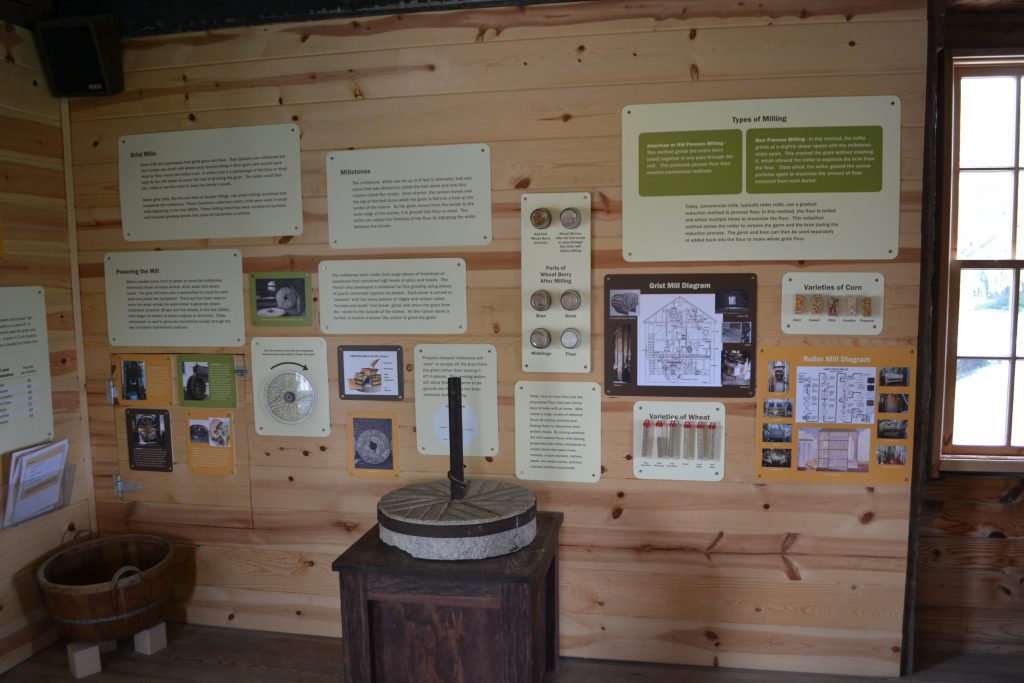
What fascinates me about this exhibit is that there are so many products that can be turned into flour or meal. An in-depth information sheet outlines how the mill works and the interactive display describes what is needed to ensure the mill runs smoothly.
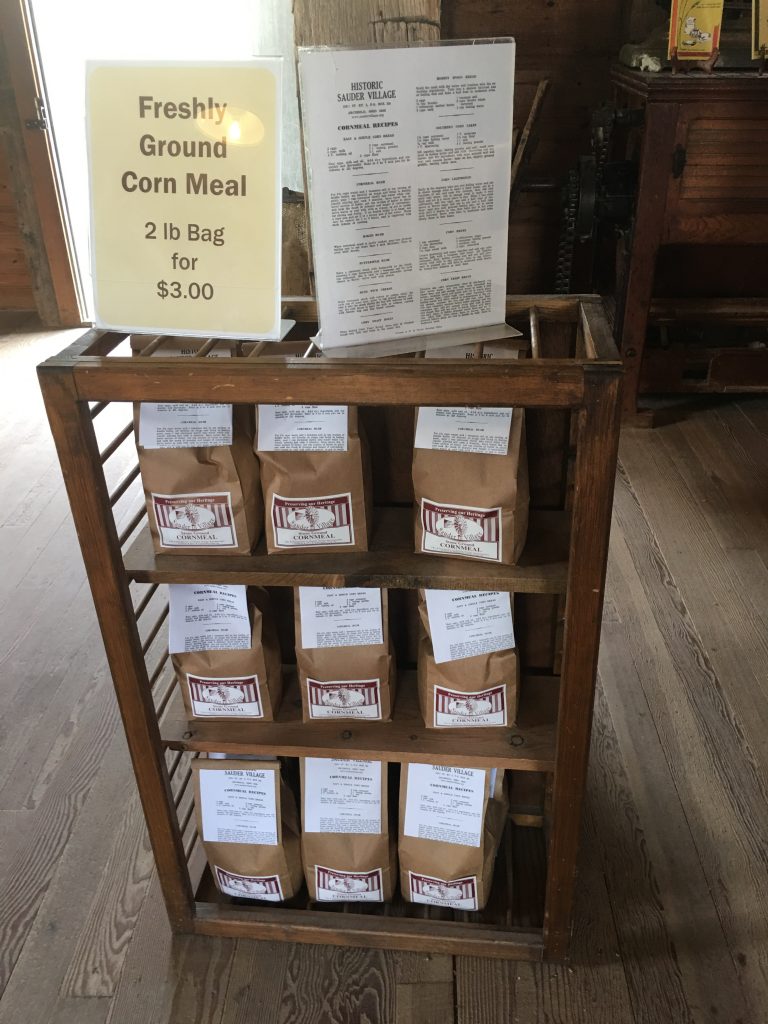
I purchased a bag of fresh corn meal to compare the fresh meal with a box for making homemade cornbread.
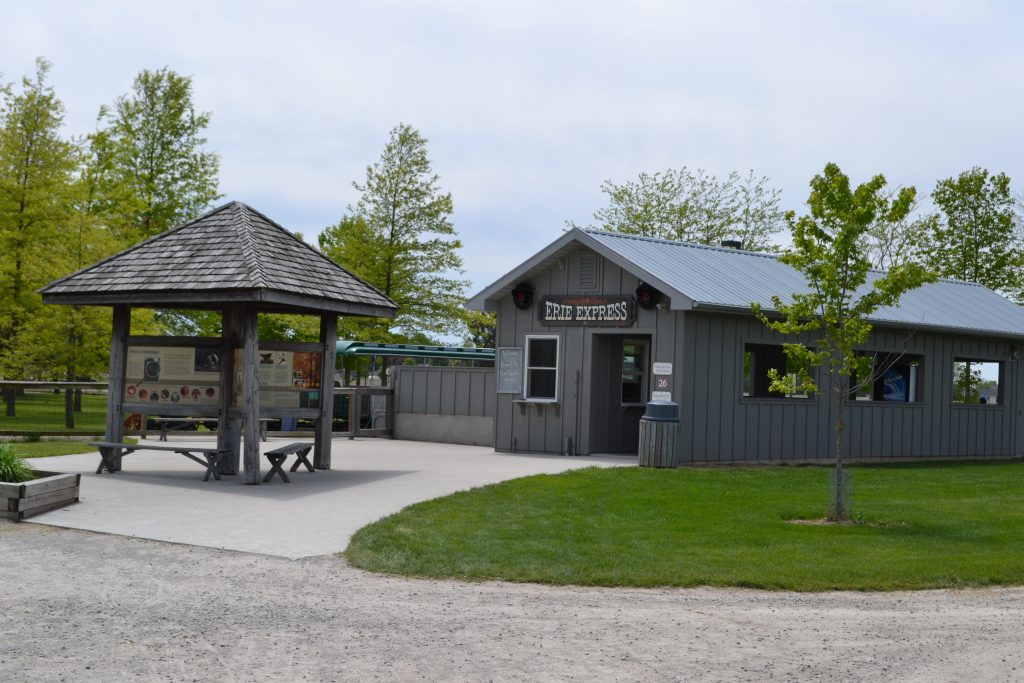
About a minute walk from the Grist Mil is the Erie Express. I decided to board the 15 minute train ride along the north end of the park where I will see glimpses of the Natives and Newcomers as well as the Pioneer Settlement. The train ride costs $2 for the multiple rides throughout the day.
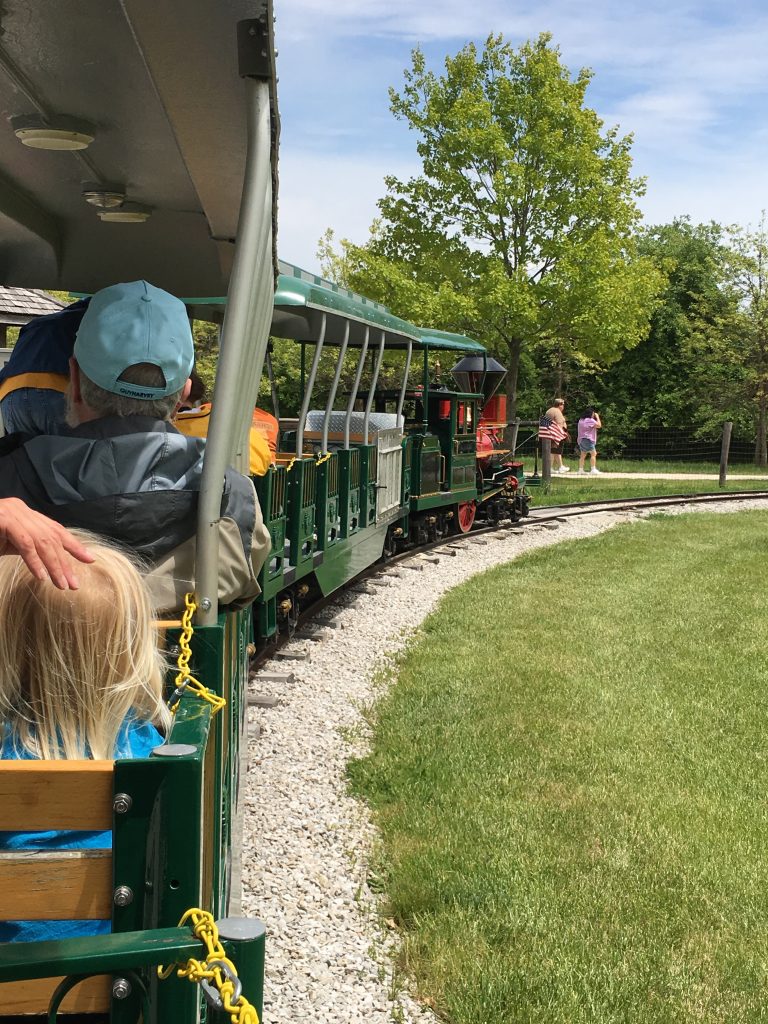
Once I disembarked the train and walked the short trip to the Natives and Newcomers exhibit. Covering the period between 1803 and 1839, I learn more about the pioneers who settled this region known as the Black Swamp area.
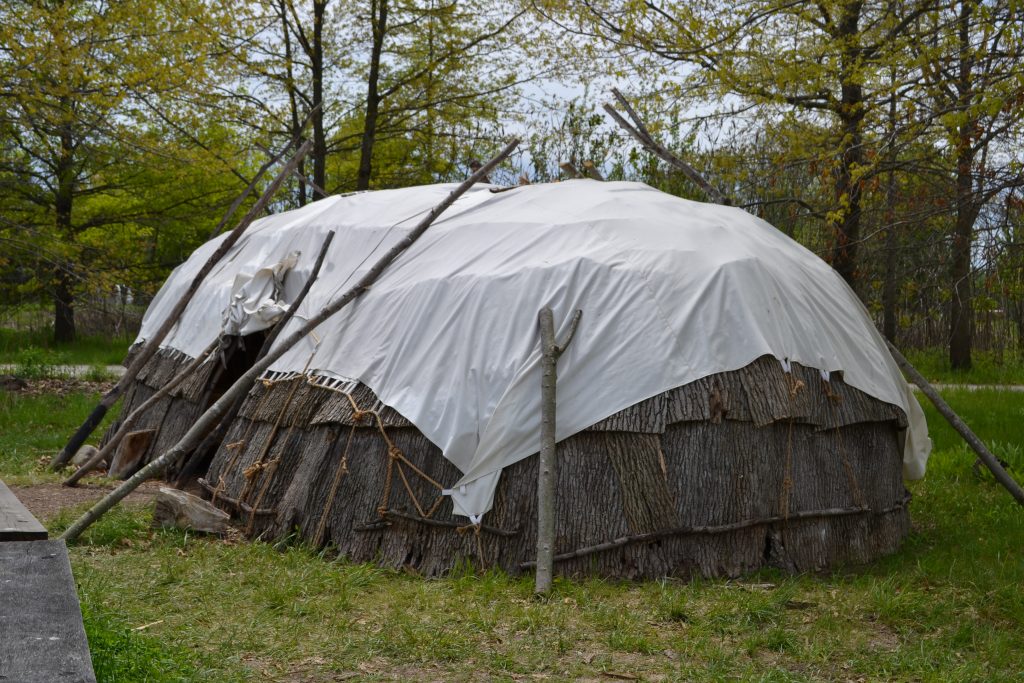
The Native American’s housing is surprisingly different than the teepee structures that I have seen in reading materials and during some of my travels out west. It seems so large and more rectangular in shape.
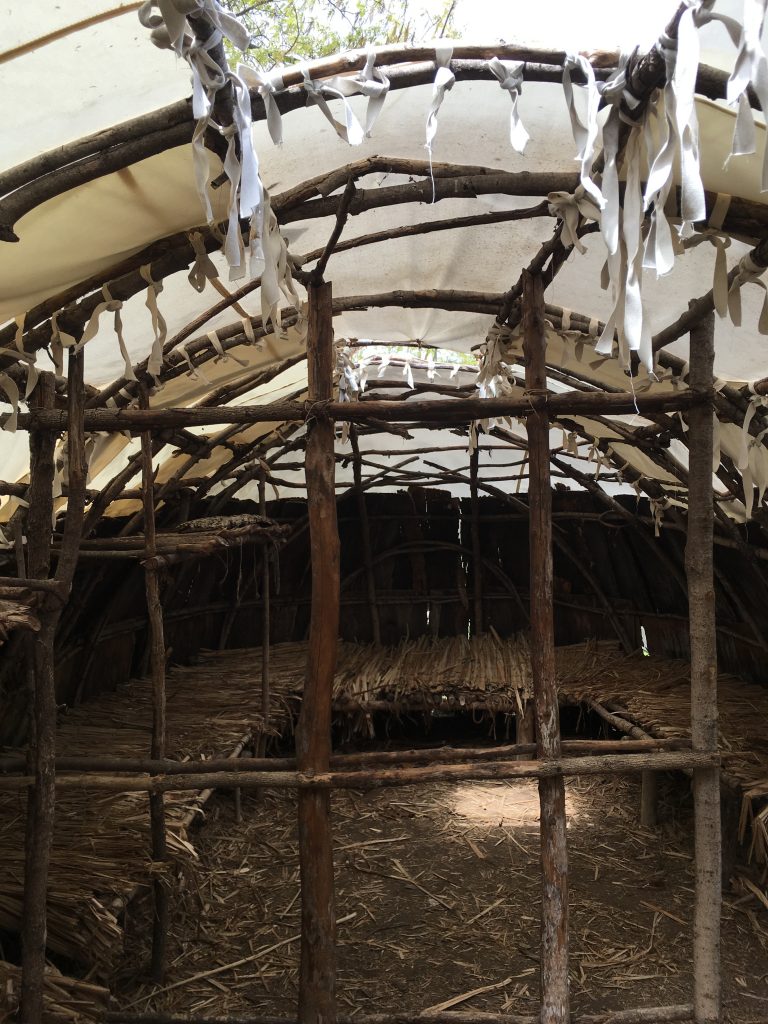
The wigwam was much larger than I had anticipated, but it was used to house two families here. In the center there was a partition that separatee each family, providing a little privacy.
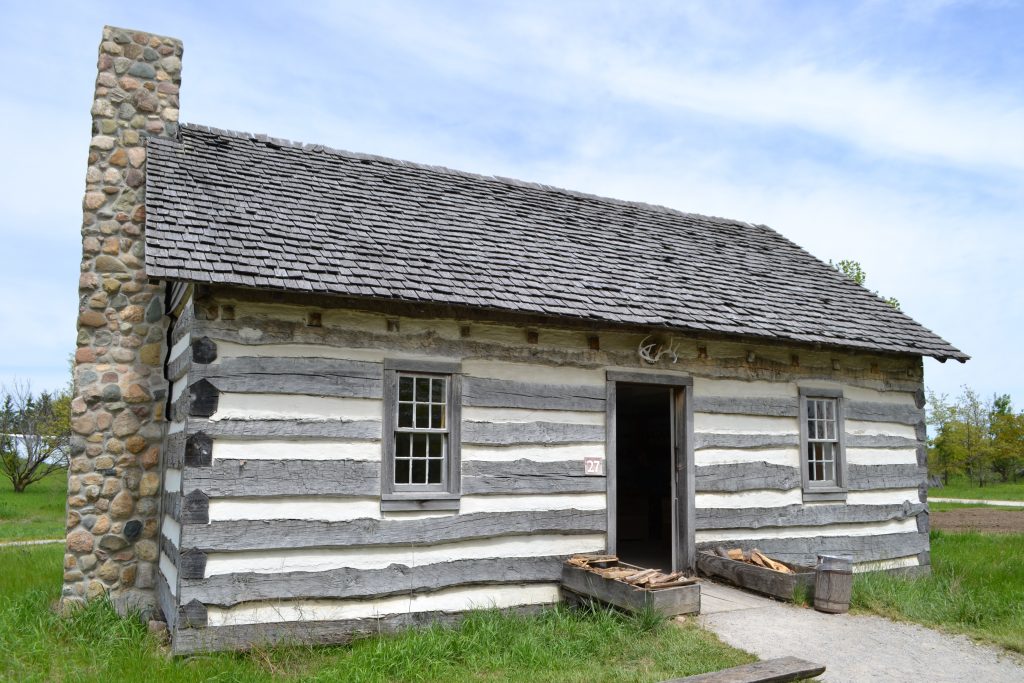
During the time that these structures were built, the settlers and the natives were already developing a trading relationship in places that were called trading posts.
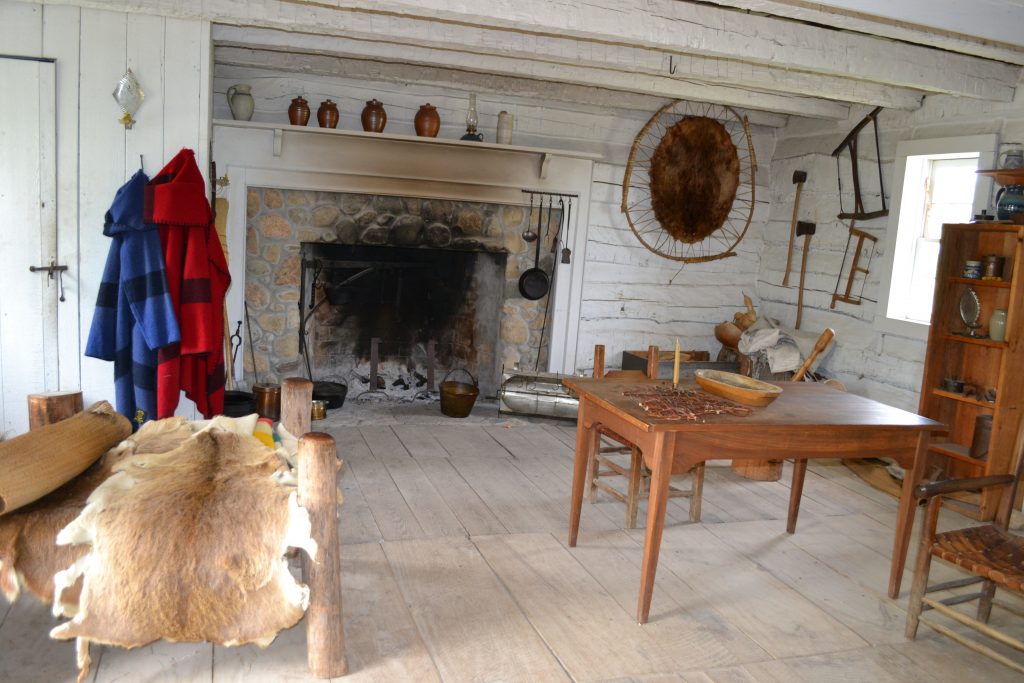
One of the more important items that settlers needed during the cold weather were animal pelts. Other items important for trade included pottery, guns, tobacco, whiskey and other items that were of interest to the trading parties.
From here, the walking path leads to the Pioneer Settlement that covers the years 1834 – 1890 when the Lauber family first arrived to this area. I am looking forward to reading more about the early settlers of the Black Swamp and to explore more of the personal lives of the residents of Fulton County. This part of my tour will be covered in Part 3 of my blog.
Have you had the opportunity to visit Sauder Village? What was your favorite sight or activity while you were here? I would love to hear about your experience if you would kindly leave a message in the comments section below! Many Thanks for reading about my visit to Sauder Village and wishing you many Happy Travels!
What to See and What to Do:
Sauder Village Living History and Farm
221611 OH-2
Archbold, OH 43502
Telephone: 419 446 2541
- Admission Fee: Adults: $24; Students, Ages 4 – 16: $18; Children, Ages 3 and under: Free; Seniors 60 and over: $22. person is permitted. 2-day Admission: Adults, $38; Students, Ages 4 – 16: $26; Valid for 2 consecutive days, non-transferable. AAA Discount: $2
- Hours: Spring (May 3 – 27): Open Wednesday to Saturday from 10AM to 3:30PM; Saturday 10AM to 4PM; Summer (May 31 – September 2): Open Wednesday to Saturday from 10AM to 5PM and Closed Sunday, Monday and Tuesday. Fall Hours (September 6 – October 8); Open Wednesday to Friday from 10AM to 3:30PM and Closed Sunday, Monday and Tuesday.
- Length of the Tour: From 2 hours to 2 days.
- Tips for Your Visit: Wear comfortable shoes as you walk through time visiting historical buildings. Download the map ahead of time and plan your day. There are several classes and demonstrations that you won’t want to miss. While there are several small shops to visit, make plans to eat at the Barn Restaurant for down-home cooking.
Where to Stay:
Sauder Heritage Inn
22611 State Route 2
PO Box 235
Archbold, OH 43502
Telephone: 800 590 9755
If you are traveling by RV, make reservations at the Sauder Village Campground.
Where to Eat:
The Barn Restaurant
22611 State Route 2
PO Box 235
Archbold, OH 43502
Telephone: 800 590 9755
Select the buffet or order from the menu loaded with down-home recipes.
What to Eat:
- Meatloaf with Mashed Potatoes
- Soups and Salads
- Fried Chicken
- Roat Beef Dinners
What to Read:
- Heritage of the Black Swamp, by Cynthia Covert Harger
Photo Guide to Sauder Village
- Visit Sauder Village in the spring for newborn baby animals
Making Friends with the Early Ohio Settlers at Sauder Village, Part 1

Celebrating forty years as Ohio’s Largest Living History Destination, Sauder Village is an amazing replica of a small town dating between 1803 to the 1920s. From the Natives and Newcomers Exhibit to the Pioneer Settlement, there are close to forty buildings that will transport you back to a simple life on the prairie.
Arriving in Archbold, the Welcome Center was my first stop to purchase my ticket and pick up a map to plan out my day. This expansive center includes a café, gift shop, restrooms and the Greenburg Gallery.
Crossing the threshold, I was immediately transported into another place and time. There were several shops, exhibits and eateries on the Village Green. Surrounded by a small community of historical homes, I began my self-guided tour at Erie’s Farm Shop, “where it all began.”

Erie Sauder felt it was important that people would have a place to visit where they could learn about pioneer life and experience it for themselves. It was his vision that led to the development of Sauder Village.
Since 1976, thousands of visitors have explored this living museum where costumed volunteers reenact the pioneer days and local artisans preserve their amazing craft. Keeping history alive at Sauder Village is a great way to appreciate the challenges and hard work of those who first settled this area.
Erie’s Farm Shop, where 16-year old Erie Sauder began his woodworking company, displays some of his original tools and replicas.

Each building is clearly numbered and guides in period costumes are available to answer any questions.

Sauder’s Cabinet Shop contained more woodworking tools. Having once owned a Sauder bookcase, I was interested in learning about his craft. I learned that Sauder had expanded their products to include church pews in the 1930s.
The Basket Shop was located next door to the cabinet shop where I watched creative craftsmen assemble baskets of all shapes and sizes. The final products were available for purchase in their store.

Exiting the Basket Shop I arrived at the Roth Barbershop which was set up as it would have been in the early 20th century. Children giggled as they sat in the barber’s chair begging for a hair cut. Playfully, the attendant declined their wish but set out to explain all of the interesting barber’s tools used for a cut and a shave. While she had their attention, she told us that the men were not permitted to sit in the barber’s chair while chewing their snuff. They had to put it on a shelf were it would stay until the barber services were completed and then they could pick it up and put it back in their lip. The children asked so many questions and it was fun to see them so engaged.

One of the most fascinating stops o my tour was the Tinsmith’s Shop. I was amazed by all of the products that were created here. From candle holders to chandeliers, the extensive collection included a fabulous selection of household items as well as tools and decorative pieces.

At the Black Swamp Cooperage, I learned that the local craftsman who made the barrels and buckets was called the Cooper. There is a beautiful display of these items that have been handcrafted by experienced woodworkers that one can purchase from the workshop. I love the contrast and design of the wood on these buckets and barrels and was hoping to find a cutting board.

At Anna’s Spinning Shop, a spinner showed our group how to make yarn. Using various types of wools, she explained how first, the wool must be combed and washed before the spinning process could begin. She also told us that the craftsman could control the size of each strand by how tight he pulled the wool as the wheel spun the fibers into string. Children as young as 3 years old would help in the process of making yarn and it was usually their job to comb the wool. From the start of creating the yarn to the knitting of a sweater, the process could take anywhere from six to twelve months.

Stepping into the herb shop, my eyes were immediately drawn to the ceiling where bundles of herbs hung from the rafters. Herbs were not only used for cooking, but for other medicinal purposes, decorating needs and to freshen their homes. It smelled fantastic as I steeped inside to look over the herbs and spices they offered for sale.

Feeling a bit underdressed entering St. Mark’s Lutheran Church, I was greeted with a smile by the organist. She was eager to play a song on the organ. Once a local German Lutheran church, it was once a place of worship for Black Swamp families in the 1900s. Equipped with church pews, a pulpit and an authentic pipe organ, the acoustics were perfect for a rendition of Amazing Grace on the 100 year pump organ.

I explored the sites surrounding the Village Green and looking back into the circle, I realized how much I had learned about the first settlers that arrived in Fulton County. Next stop, the Elmira Depot.

The Elmira Depot was an original train stop along the Wabash Railway just a couple of miles from Archbold. Passengers could ride the Wabash Cannonball on the Detroit – St. Louis route starting in 1949. The depot was in use until It was brought to Sauder Village in 1968 and this is definitely one of the highlights of the park.

Inside, kids had a blast weighing themselves on the scale used to weigh goods transported by train.
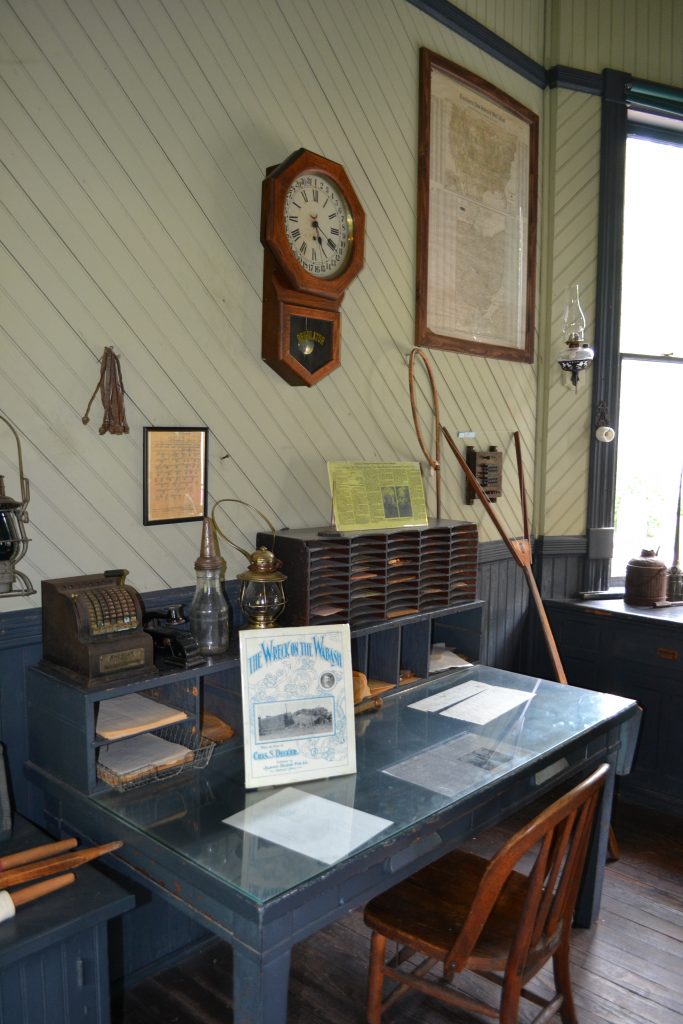
I entered through the door opposite of the scales into the administrative office. Passengers could purchase their tickets while assistants sent telegraphs and carried out secretarial tasks.

My favorite part of the depot was the Baggage Room where objects that were transported on the railways were on display. Shipping routes were published on a large map while a placard displayed the American Morse Code. I watched a group of children try their hand at sending a telegraph using the morse code chart above the machine. Most of them opted to tap out their names and were having a great time pretending to send messages from one station to the next.
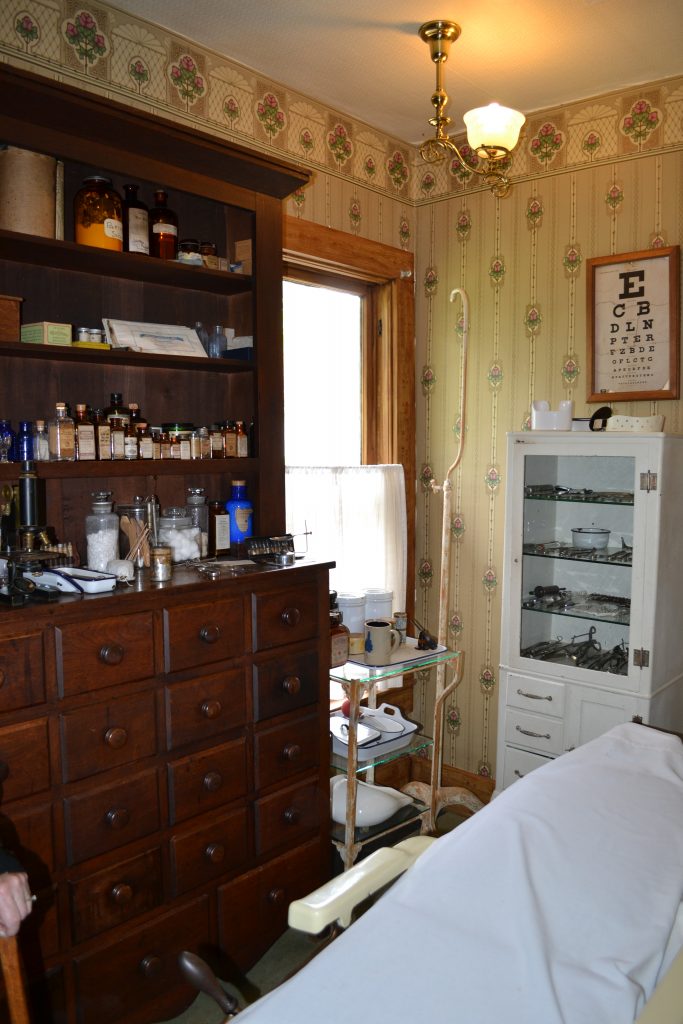
Just a few feet away I explored Dr. McGuffin’s Office. I was reminded of how far we’ve come from the medical care that was available back in the late 1800s. Sometimes the doctor would not only have to help the local people who were sick, he may have also had to act as the local dentist by pulling a tooth or make house calls to tend to an injured horse. He had a very important job within the community and was a well-respected figure.
I was impressed with the medical instruments encased in cabinets and the medicines and herbal remedies that were sitting on the shelf. The doctor was also in charge of prescribing medication which would have been kept on the premises. From his office, he could administer the treatment or make house calls.

The next building on my Sauder Village map is the District 16 Schoolhouse which was an original one-room school house where children attended school. The teacher played an important role, not only in the teaching of the children, but attending to additional duties. Some of these responsibilities included chopping firewood for the stove or ensuring that there was plenty of water in the bucket from which the children would drink throughout the day. Children that attended rural schools were only required to complete an 8th grade education and the ages of the school children could range from ages 6 years to 21.
With so many levels of education coming together in one room, it must have been a challenge for the teacher not to mention giving each student the attention they deserved.
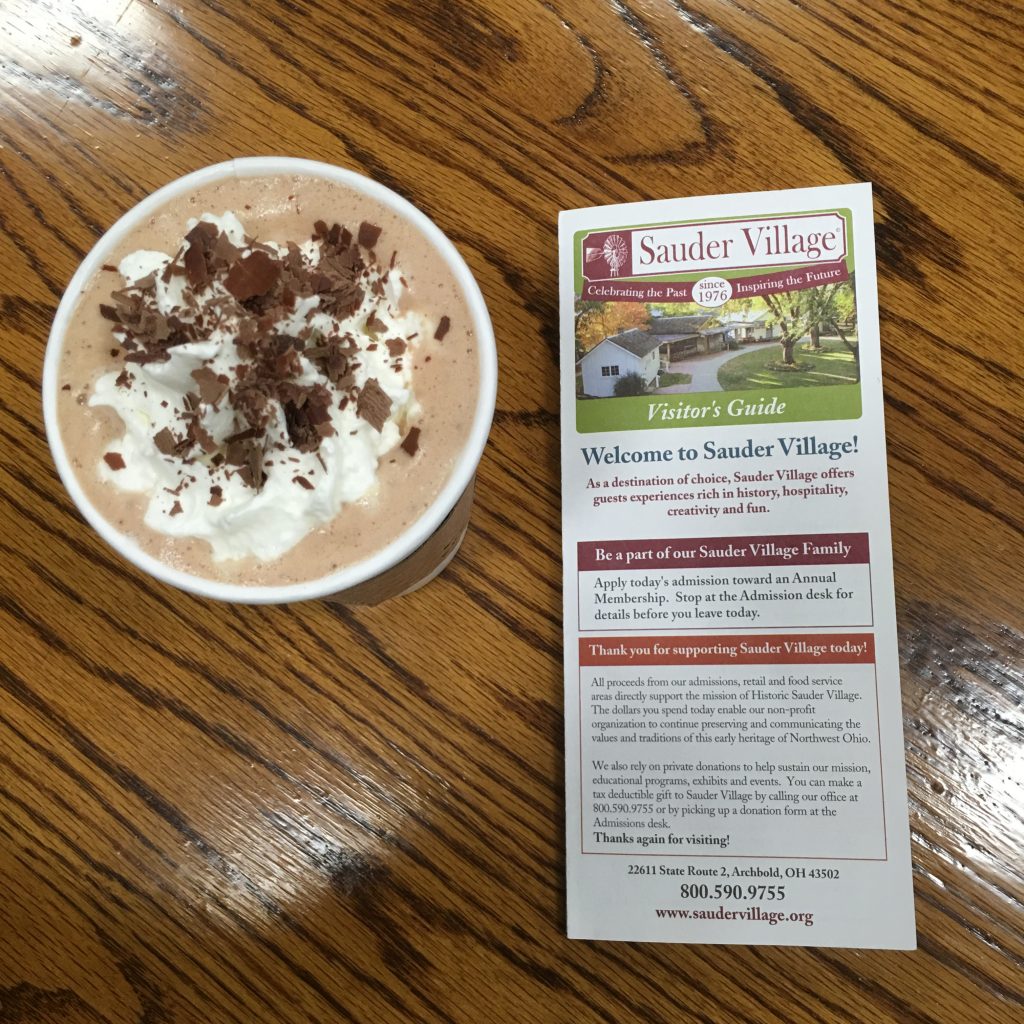
I was nearly halfway through the list of historical buildings when I happened upon the Stella Leona Chocolates & Coffee shop. It was a welcome sight to enjoy a café mocha and the milk chocolate shavings. I was tempted to try one of their delicious chocolates, but decided to wait until after lunch. With a little energy boost, I was ready to tackle the remaining sites.

For those that love to quilt, the Threads of Tradition Quilt Shop should be on the top of your list. I was able to find out anything and everything I have ever wanted to know about quilting. There are over 3500 bolts of fabric, patterns, instructional books, gifts and hand quilting demonstrations….every quilter’s dream.

Not far from the Quilt Shop is Lauder’s General Store. This place is a museum in itself with so many products that were popular in the 19th and 20th centuries as well as those items that even interest kids today. I took a walk down memory lane checking out past toys that I remembered as a child. In some ways it reminded me of the mercantile in Little House on the Prairie but with a focus more on toys, dolls, and its candy collection. I could have easily spent hours in this store.

I quickly passed by the The W.O. Taylor Printing Office on my way to visit Burlington Glass Works. The building was closed for the day, but it was once the newspaper office of Archbold in the early 20th century. It would have been fun to see the printing presses and possibly some historical newspapers.

I overheard that the glass maker, Mark Matthews had just fired up his oven and was preparing to create one of his internationally acclaimed glass products. When I arrived, the glass was heating up so I decided to stay. Within minutes he began to manipulate the glass that would later be used to create some of his fascinating, colorful marbles.
I was surprised at the length of the process, so I did not to see the final masterpiece, but I am sure it was spectacular. Inside of his studio, he displayed many of his works which were available for sale.
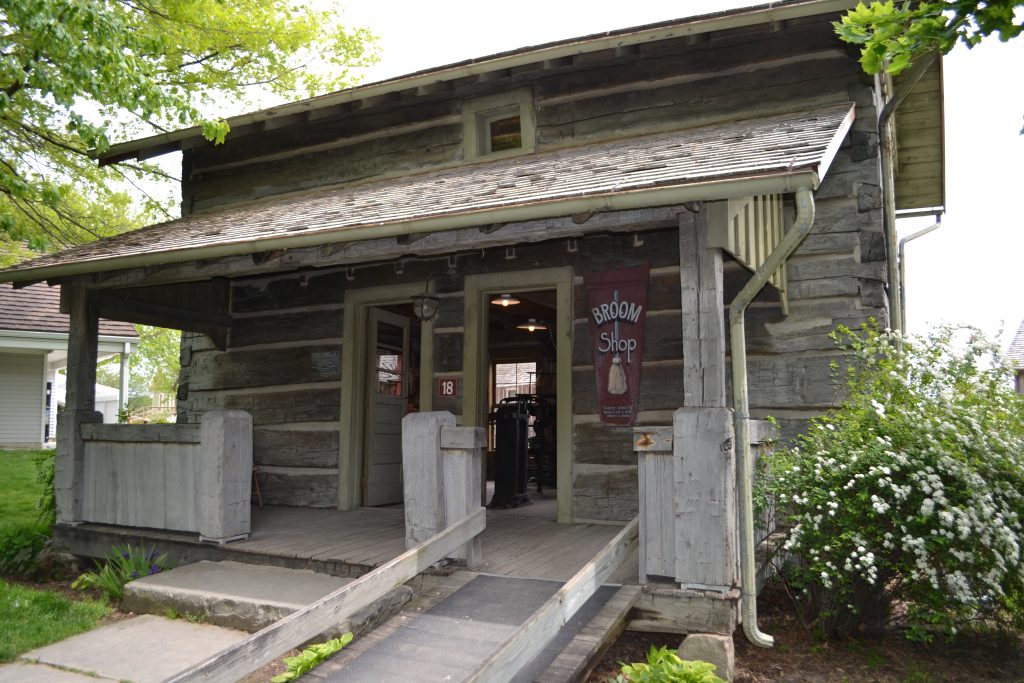
My last stop before heading out towards the perimeter of the village was the Broom Shop.
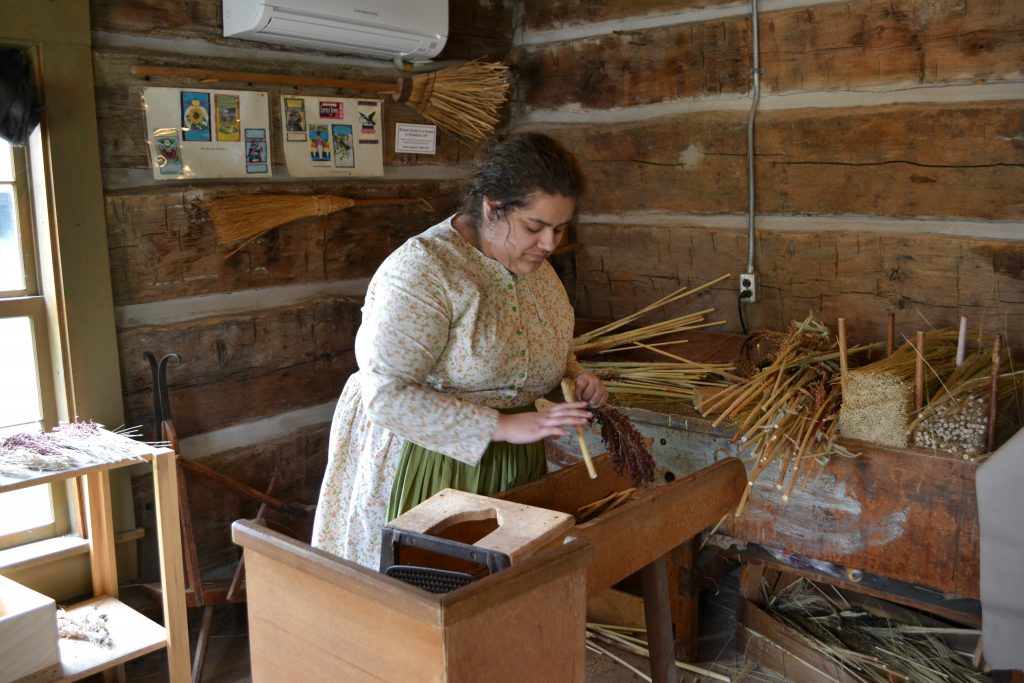
It was entertaining and educational to watch the talented broom maker create a decorative broom. There was a large selection of brooms for sale and it took some time for me to made a selection. I have often heard that handmade brooms work amazingly well when sweeping floors and was happy to have purchased one.
Exiting the ship, I realized I was close to the parking lot, so I took my new broom to the car and would start my tour again at the 1920s Grime Homestead. I couldn’t wait to explore the rest of this amazing village.
Please note that this is Part 1 of my visit due to the extent of the amazing opportunities to learn about the historical sites. Check out Part 2 and Part 3 to read about the second half of my exploration of Sauder Village.
Have you had the opportunity to visit Sauder Village? What was your favorite place to visit or activity while you were here? I would love to hear about your experience if you would kindly leave a message in the comments section below! Many Thanks and Happy Travels!
What to See and What to Do:
Sauder Village Living History and Farm
221611 OH-2
Archbold, OH 43502
Telephone: 419 446 2541
- Admission Fee: Adults: $24; Students, Ages 4 – 16: $18; Children, Ages 3 and under: Free; Seniors 60 and over: $22. person is permitted. 2-day Admission: Adults, $38; Students, Ages 4 – 16: $26; Valid for 2 consecutive days, non-transferable. AAA Discount: $2
- Hours: Spring (May 3 – 27): Open Wednesday to Saturday from 10AM to 3:30PM; Saturday 10AM to 4PM; Summer (May 31 – September 2): Open Wednesday to Saturday from 10AM to 5PM and Closed Sunday, Monday and Tuesday. Fall Hours (September 6 – October 8); Open Wednesday to Friday from 10AM to 3:30PM and Closed Sunday, Monday and Tuesday.
- Length of the Tour: From 2 hours to 2 days.
- Tips for Your Visit: Wear comfortable shoes as you walk through time visiting historical buildings. Download the map ahead of time and plan your day. There are several classes and demonstrations that you won’t want to miss. While there are several small shops to visit, make plans to eat at the Barn Restaurant for down-home cooking.
Where to Stay:
Sauder Heritage Inn
22611 State Route 2
PO Box 235
Archbold, OH 43502
Telephone: 800 590 9755
If you are traveling by RV, make reservations at the Sauder Village Campground.
Where to Eat:
The Barn Restaurant
22611 State Route 2
PO Box 235
Archbold, OH 43502
Telephone: 800 590 9755
Select the buffet or order from the menu loaded with down-home recipes.
What to Eat:
- Meatloaf with Mashed Potatoes
- Soups and Salads
- Fried Chicken
- Roast Beef Dinners
What to Read:
- Heritage of the Black Swamp, by Cynthia Covert Harger
Photo Guide to Sauder Village
- Visit Sauder Village in the spring for newborn baby animals
Disclosure: Please refer to our blog disclaimer tab for more information.